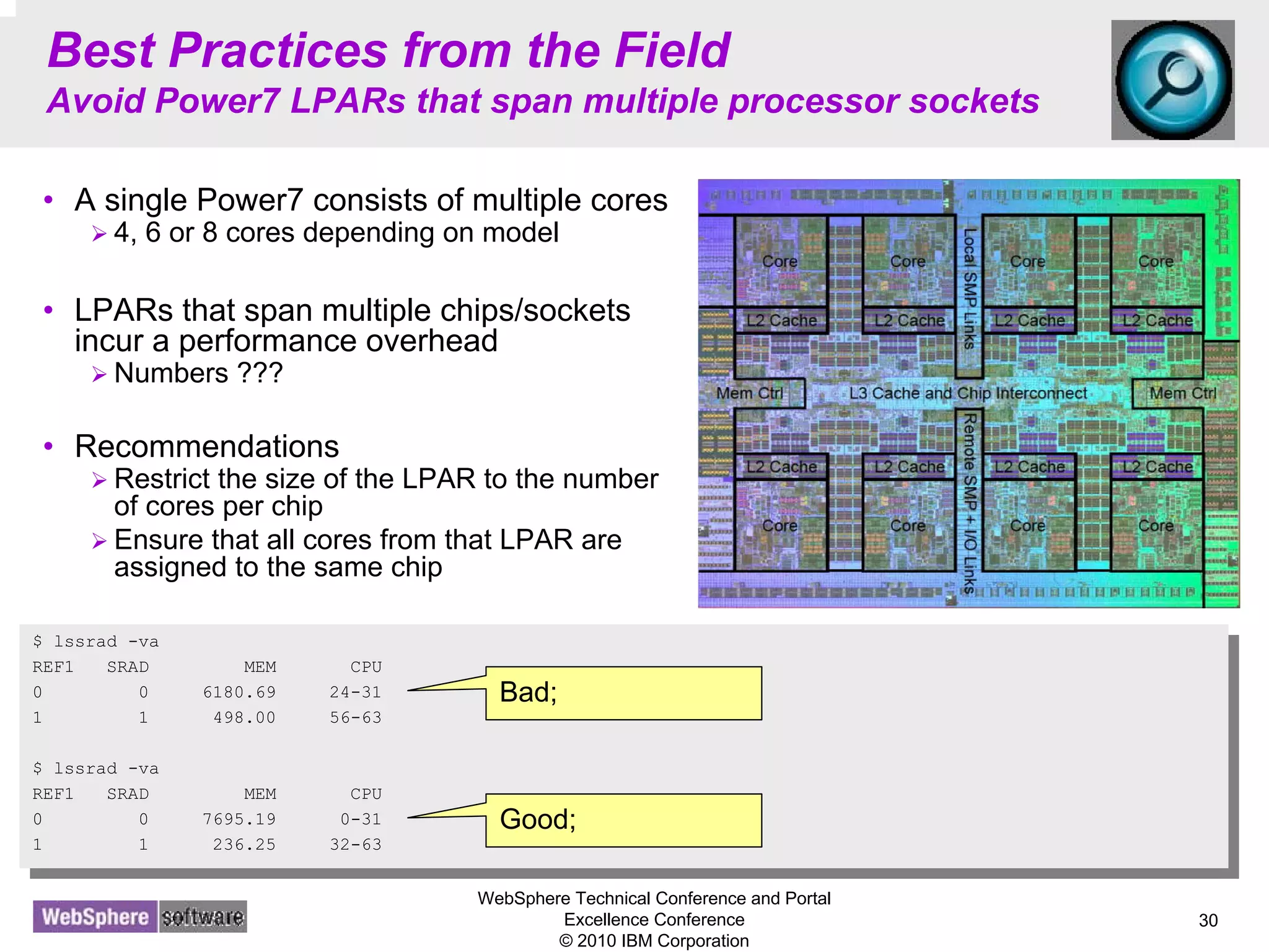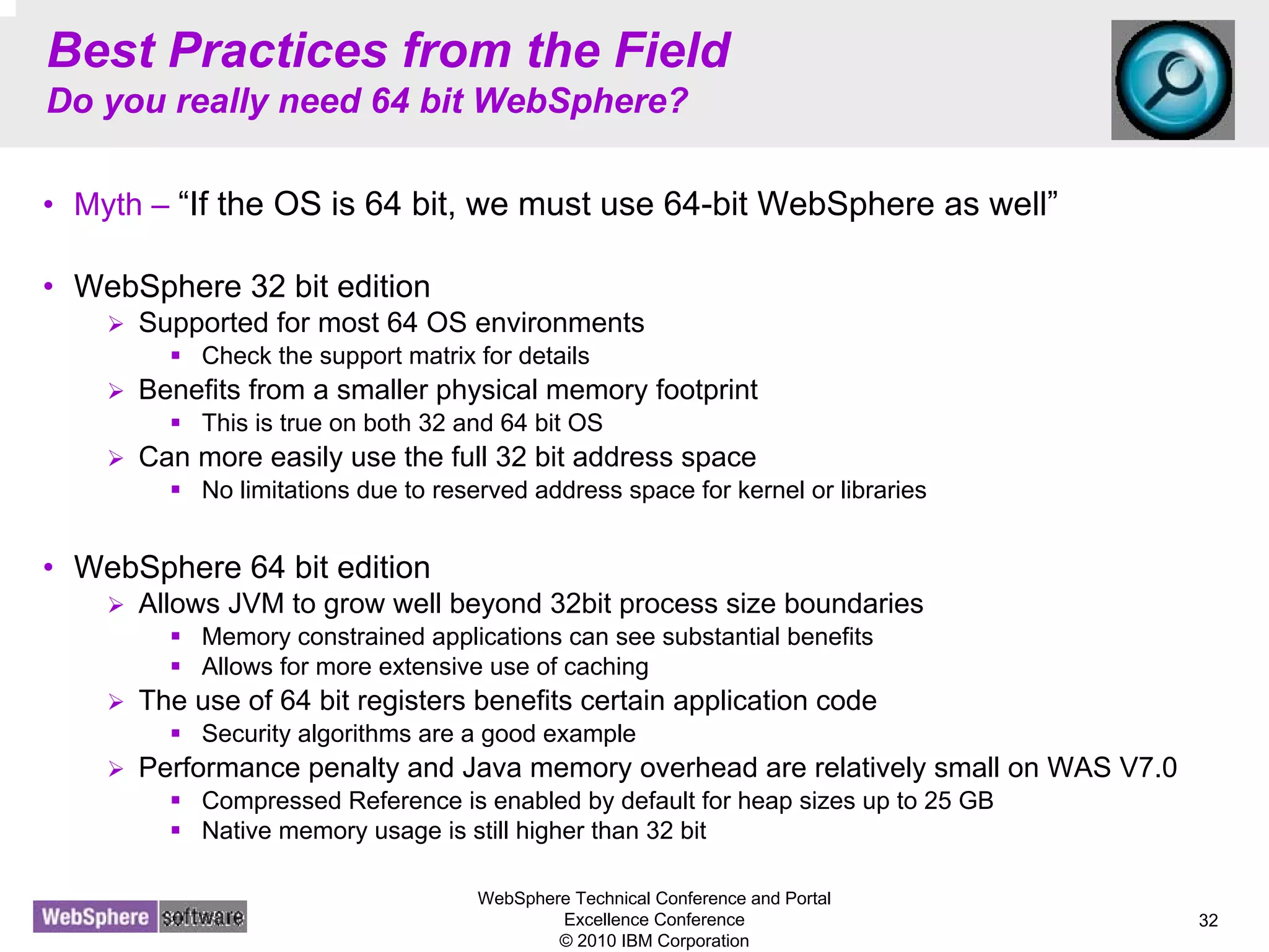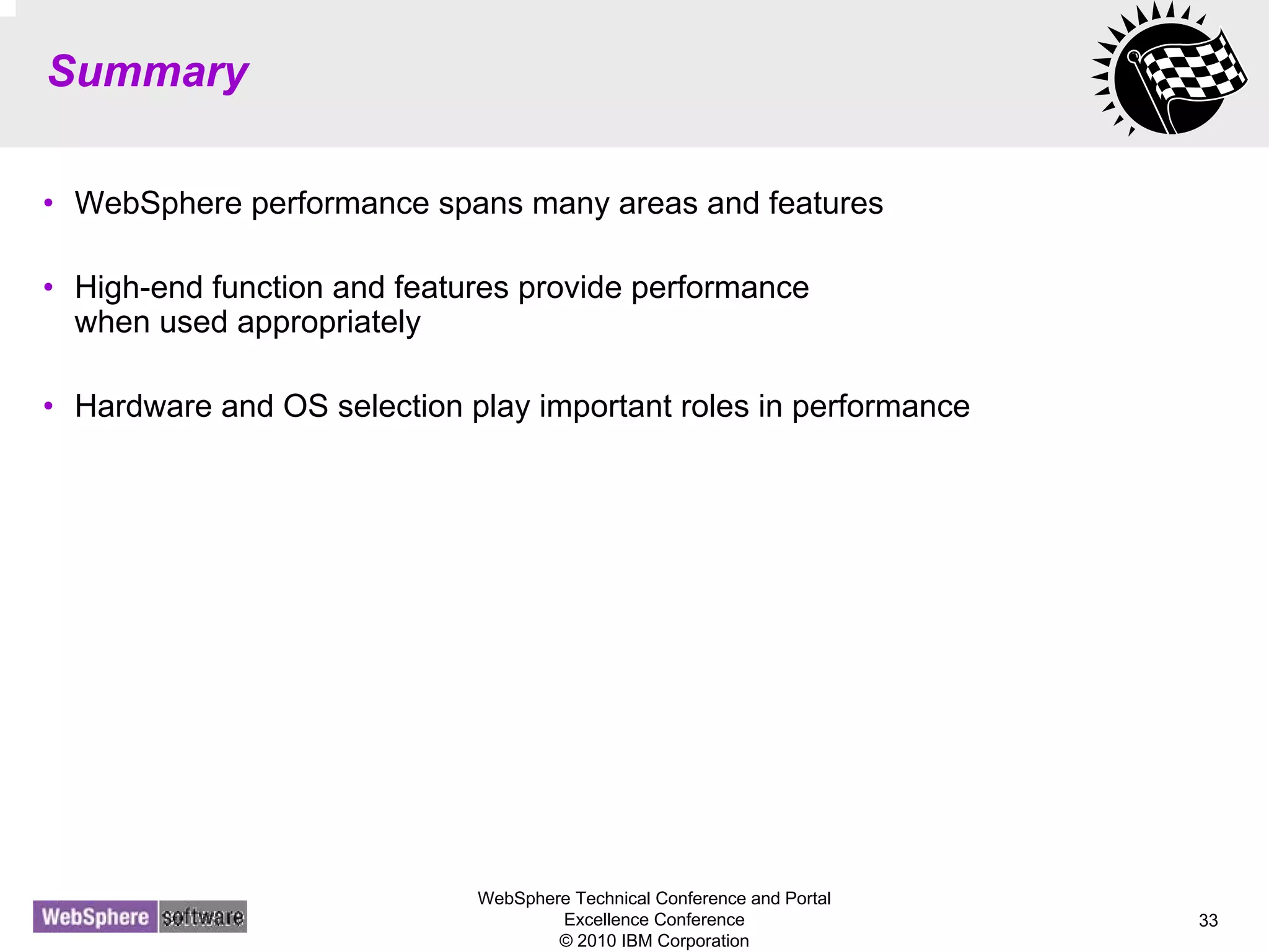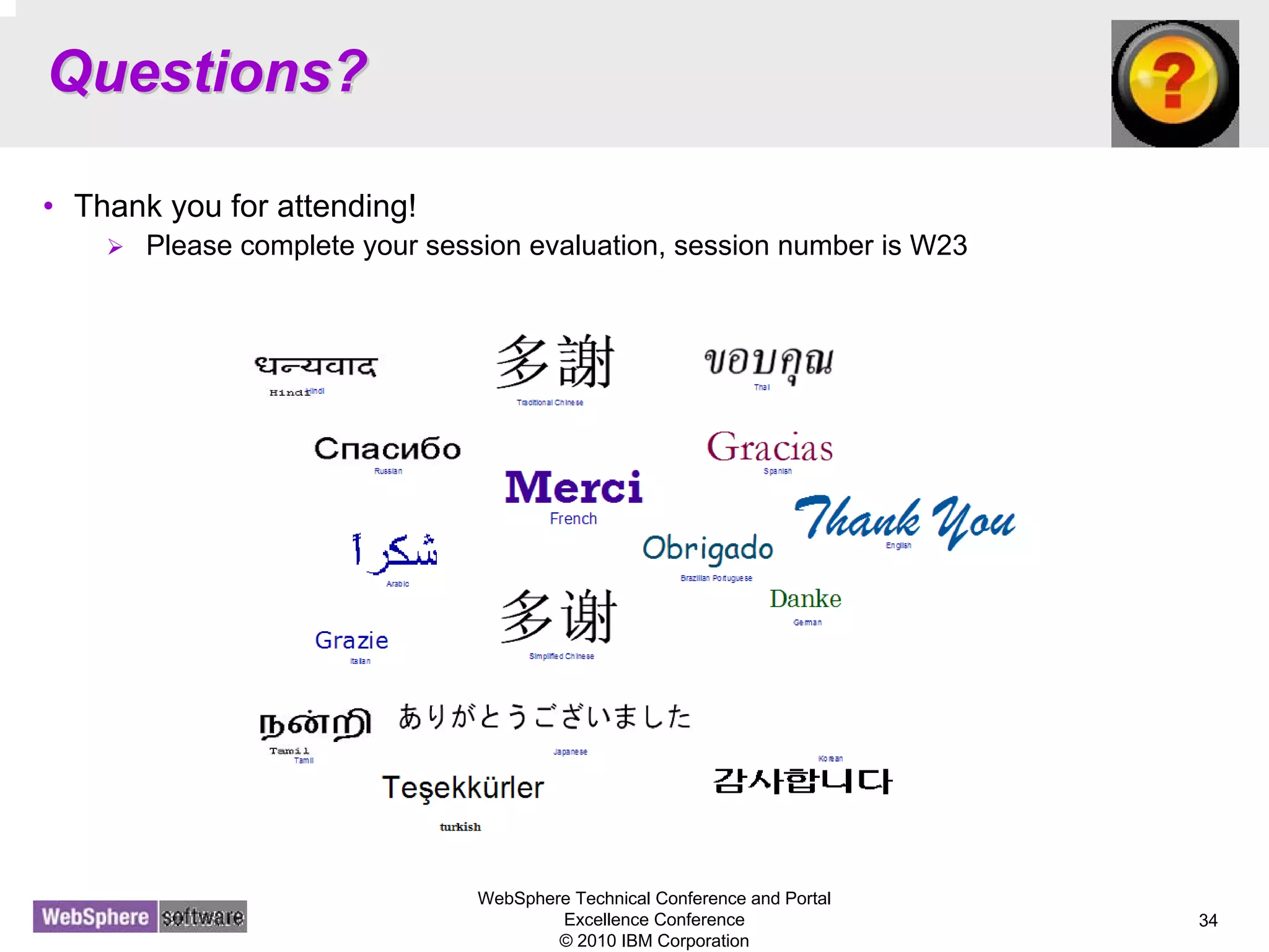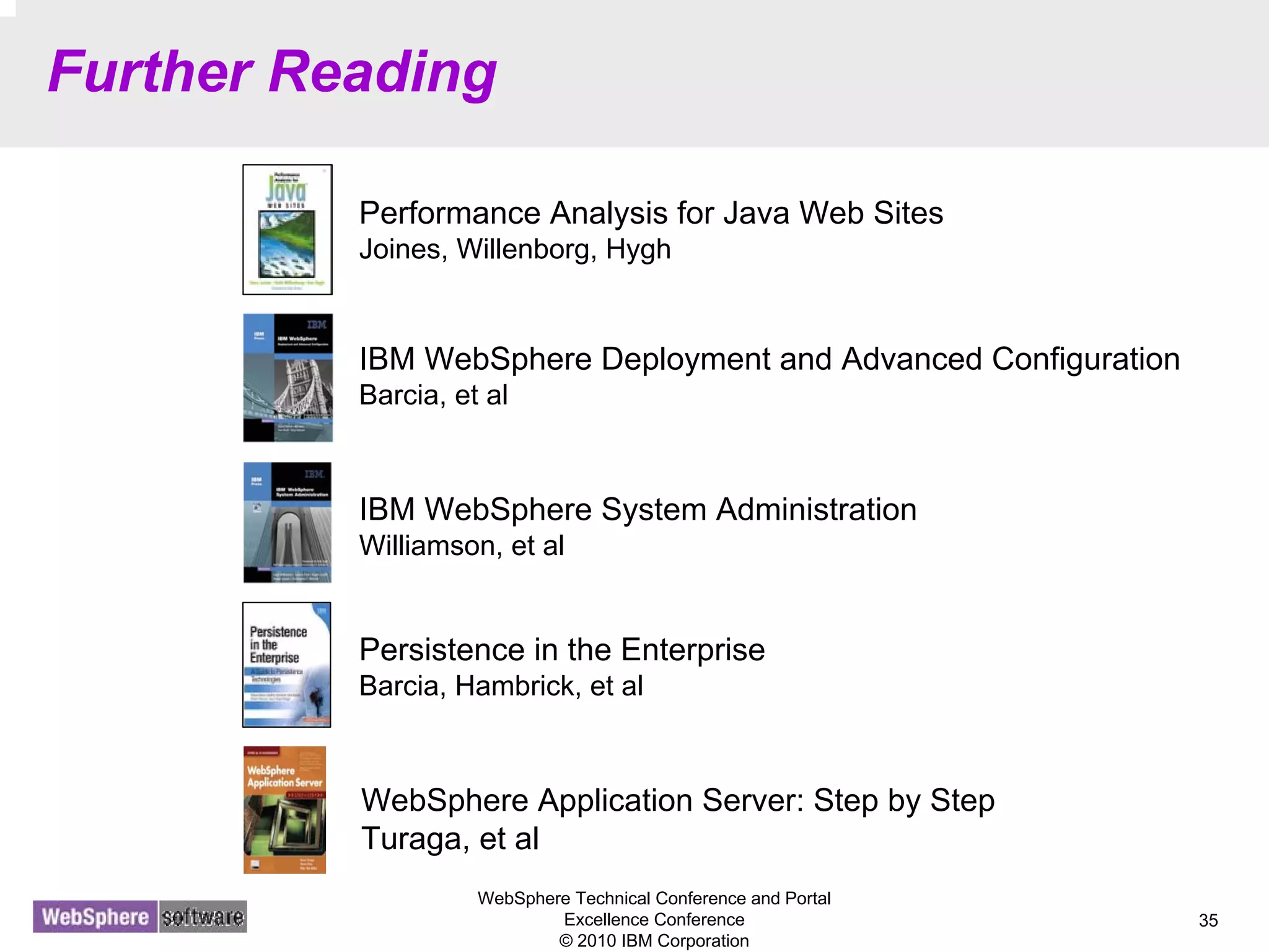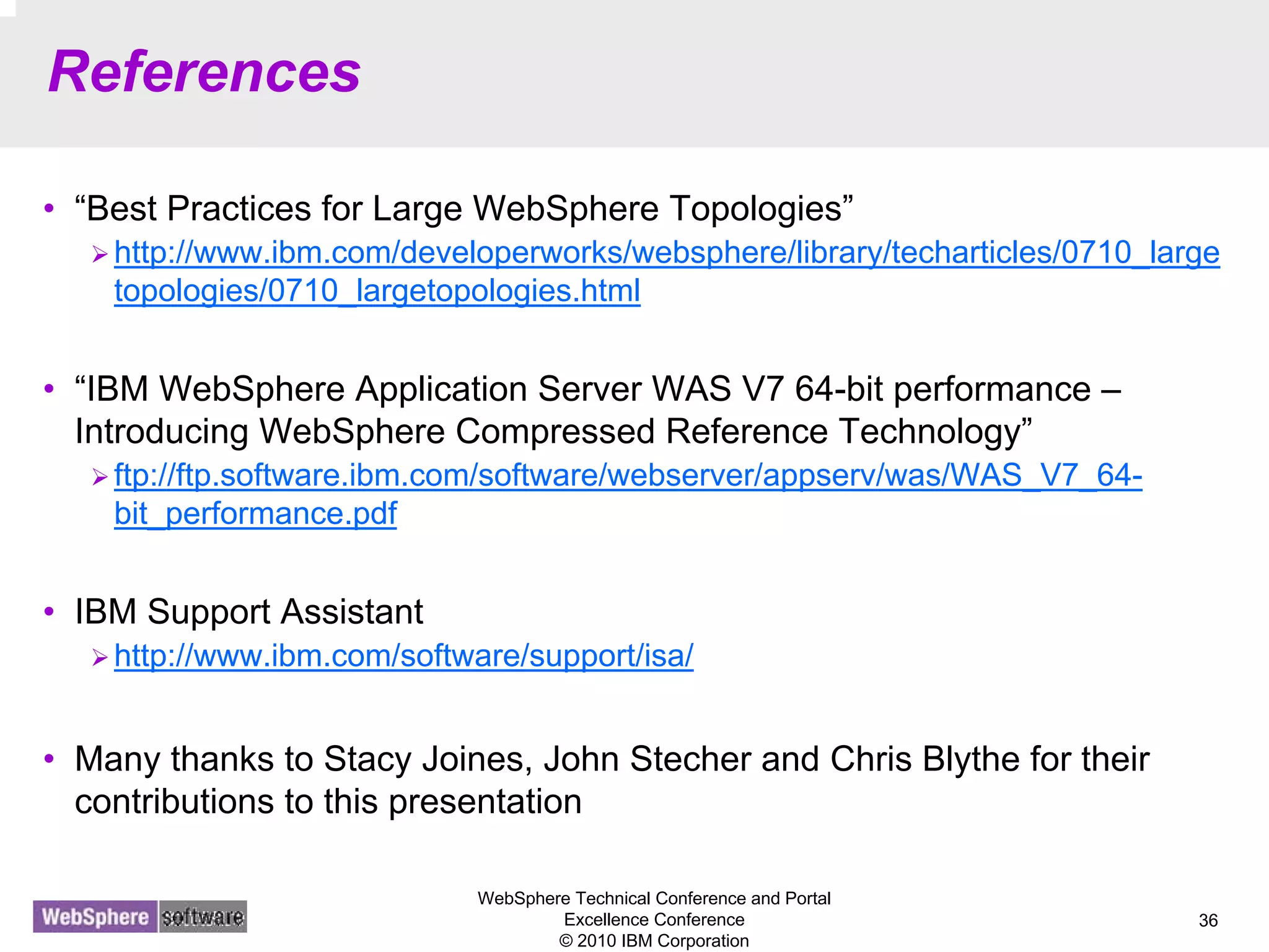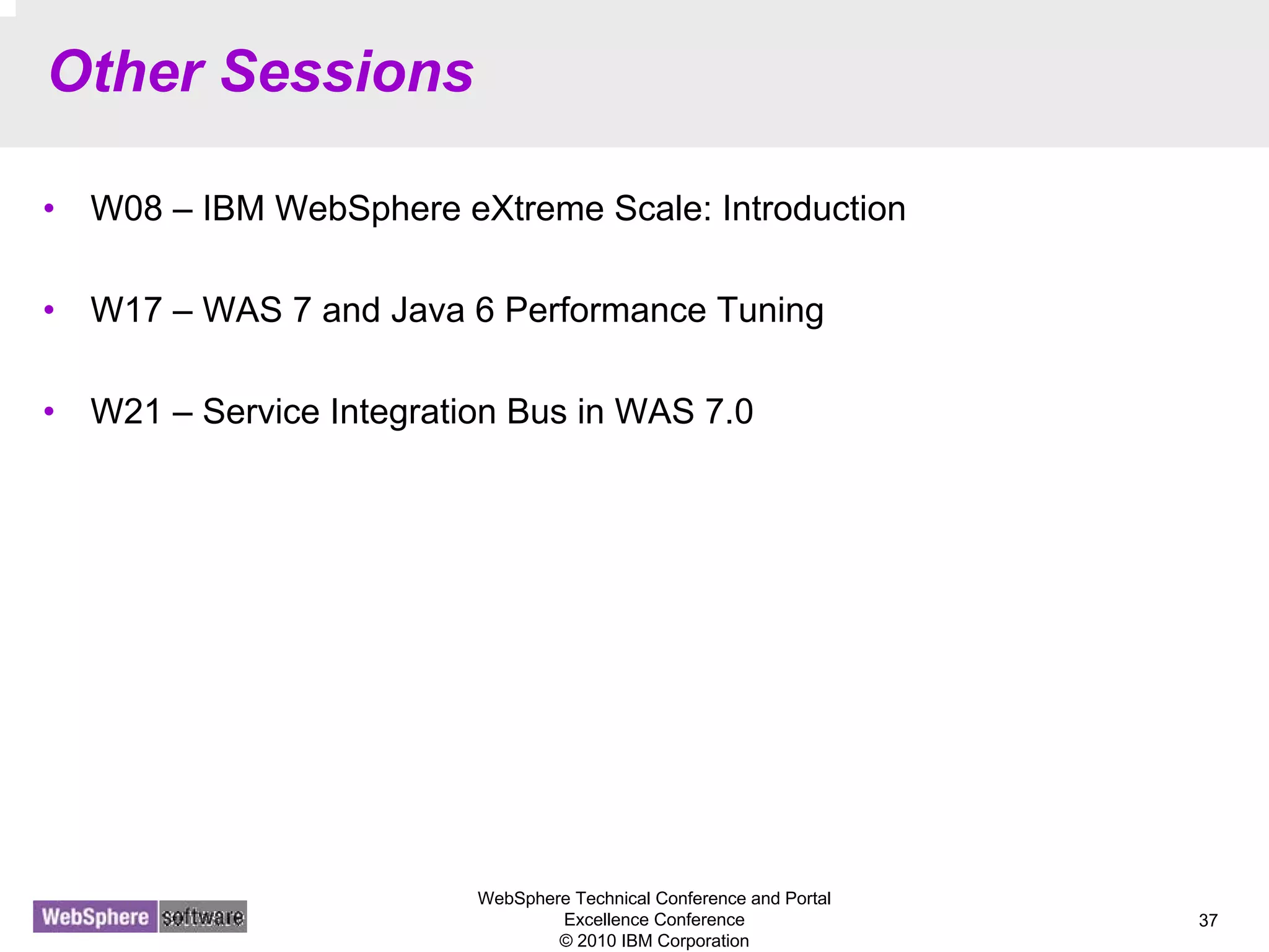The document provides insights into advanced performance tactics for optimizing WebSphere applications, focusing on key areas like thread pooling, high availability, and service integration. It discusses best practices and performance improvements, offering guidance on sizing thread pools, managing JDBC connections, and leveraging Java Virtual Machine configurations for better efficiency. The content emphasizes the importance of careful tuning and understanding of hardware capabilities for achieving optimal WebSphere performance.

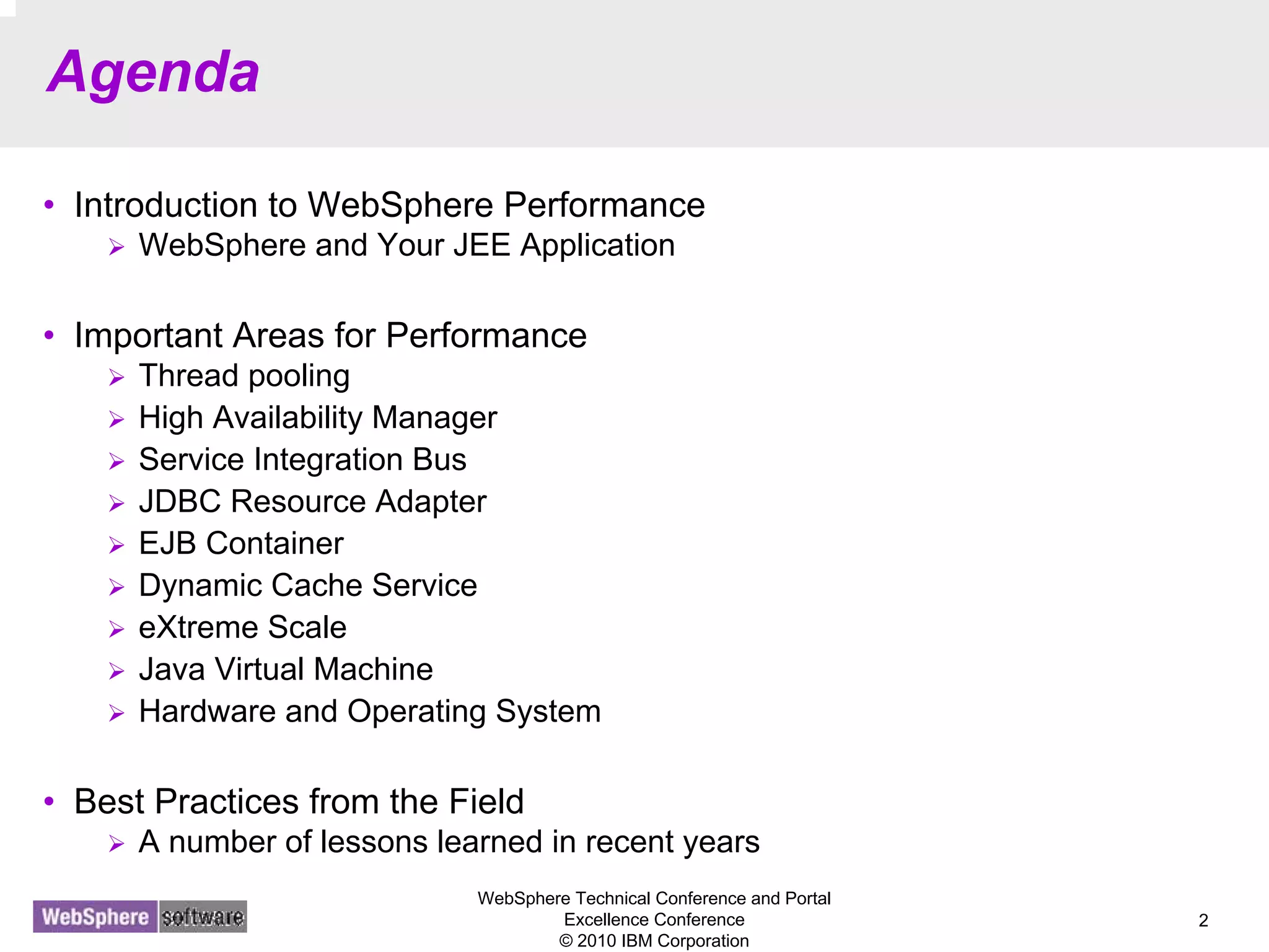
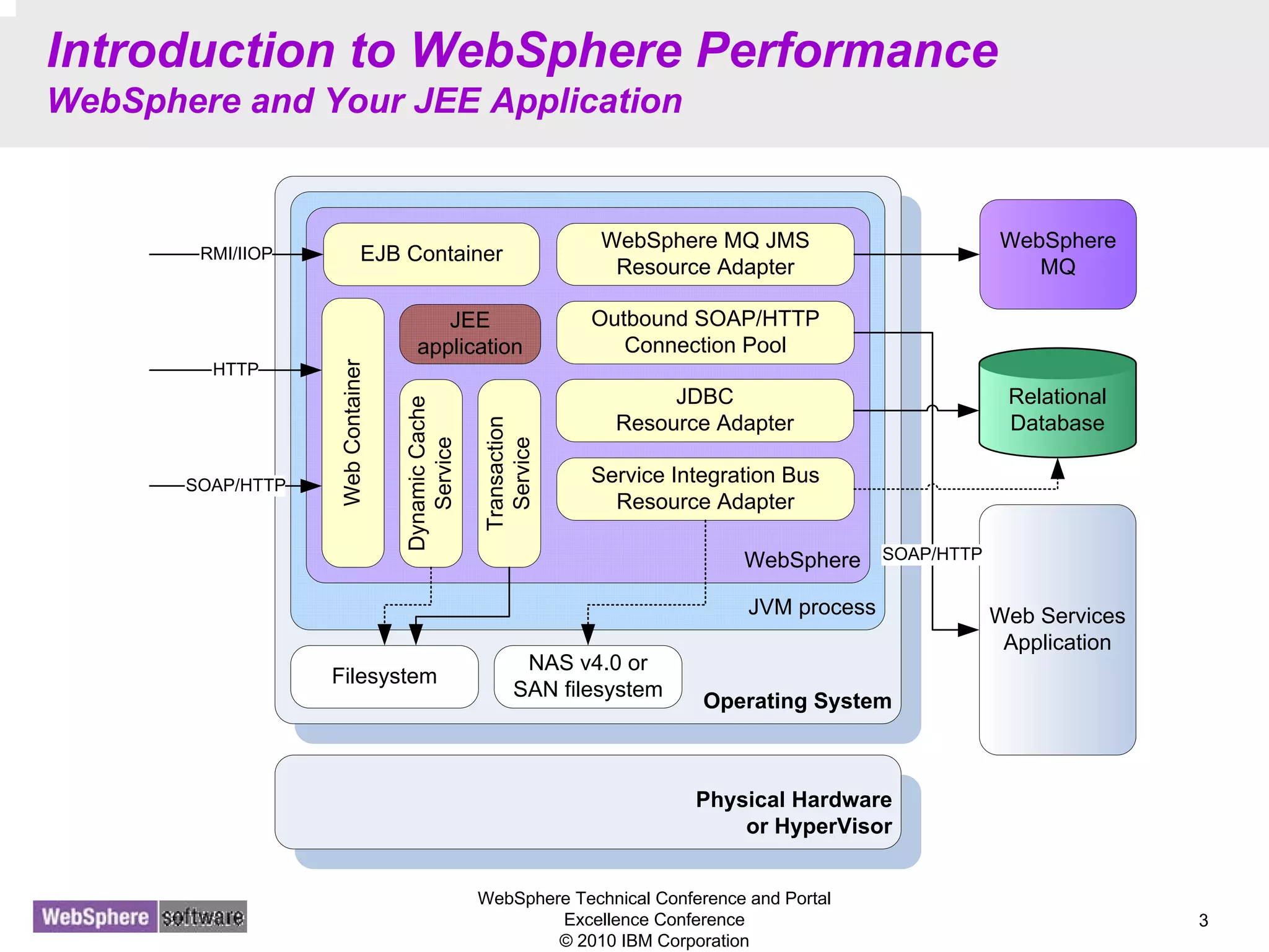
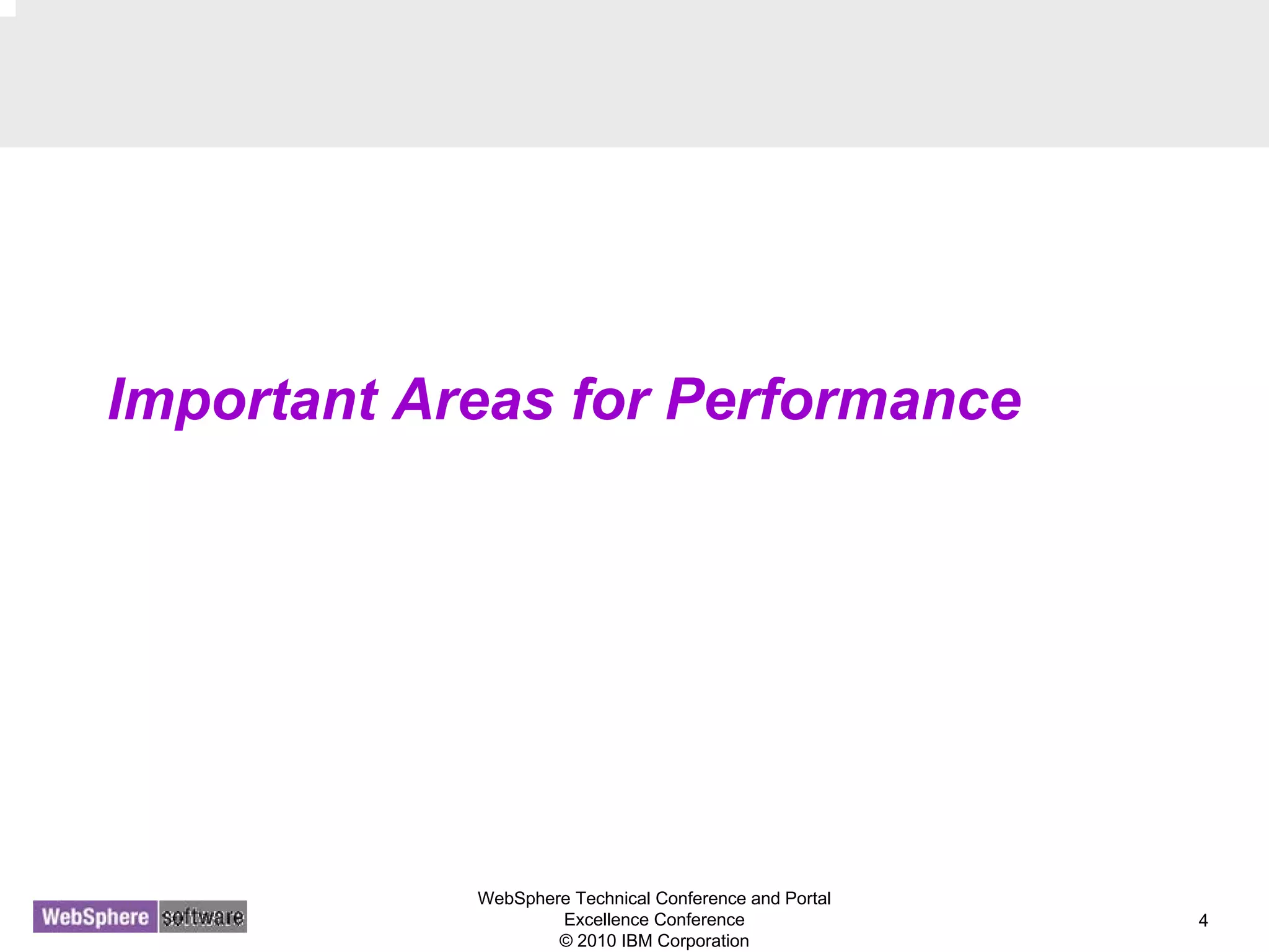
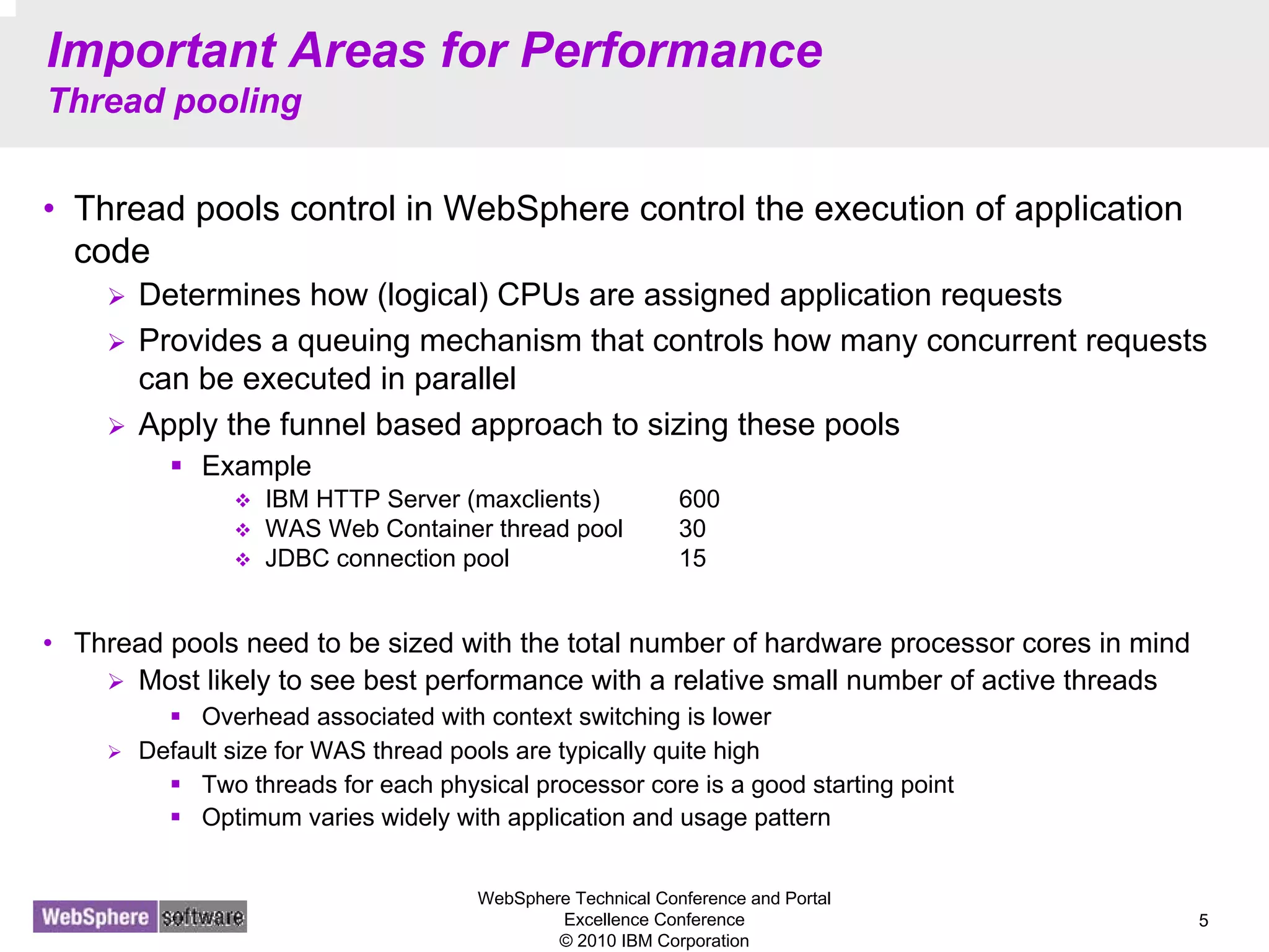
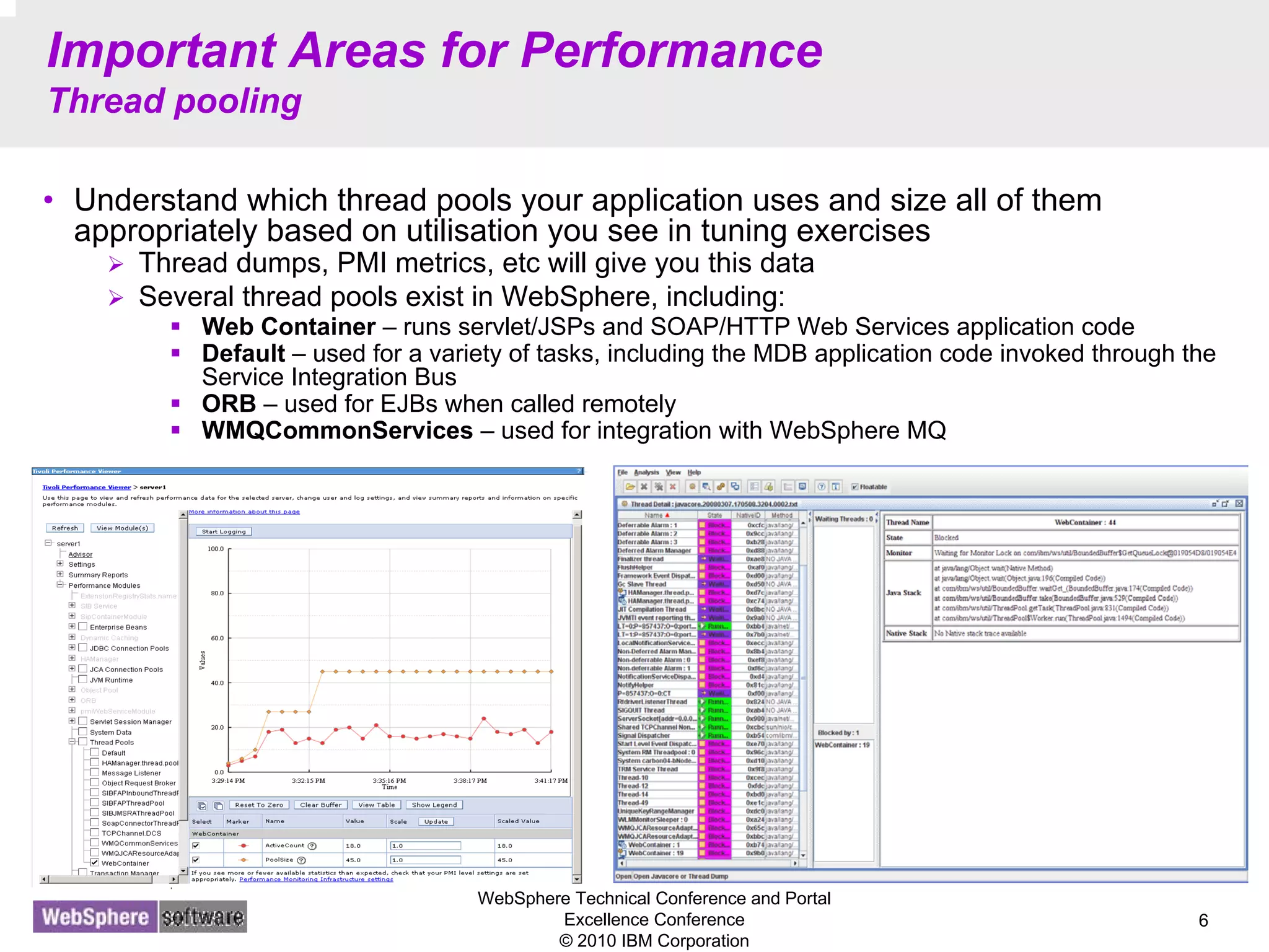
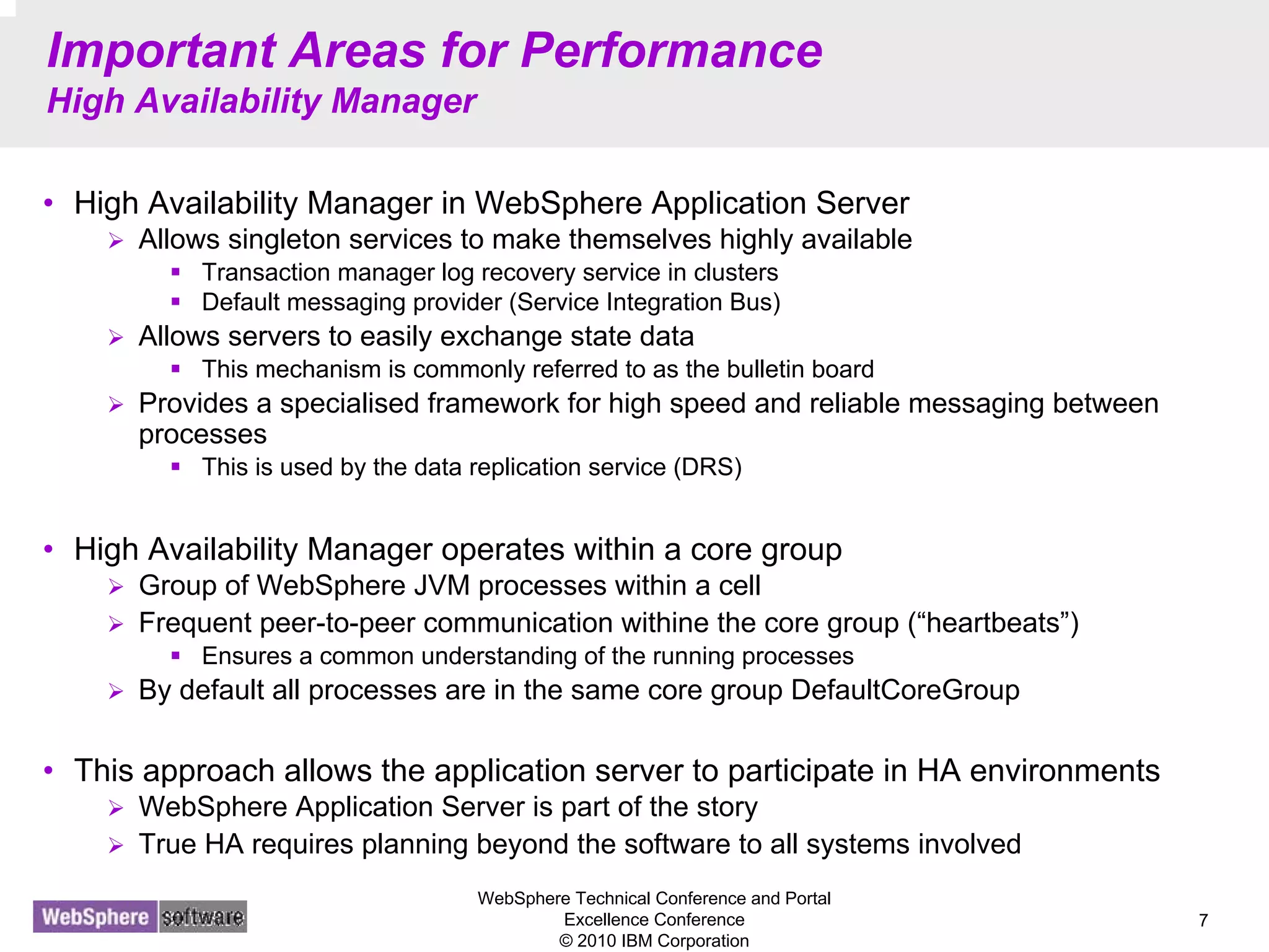
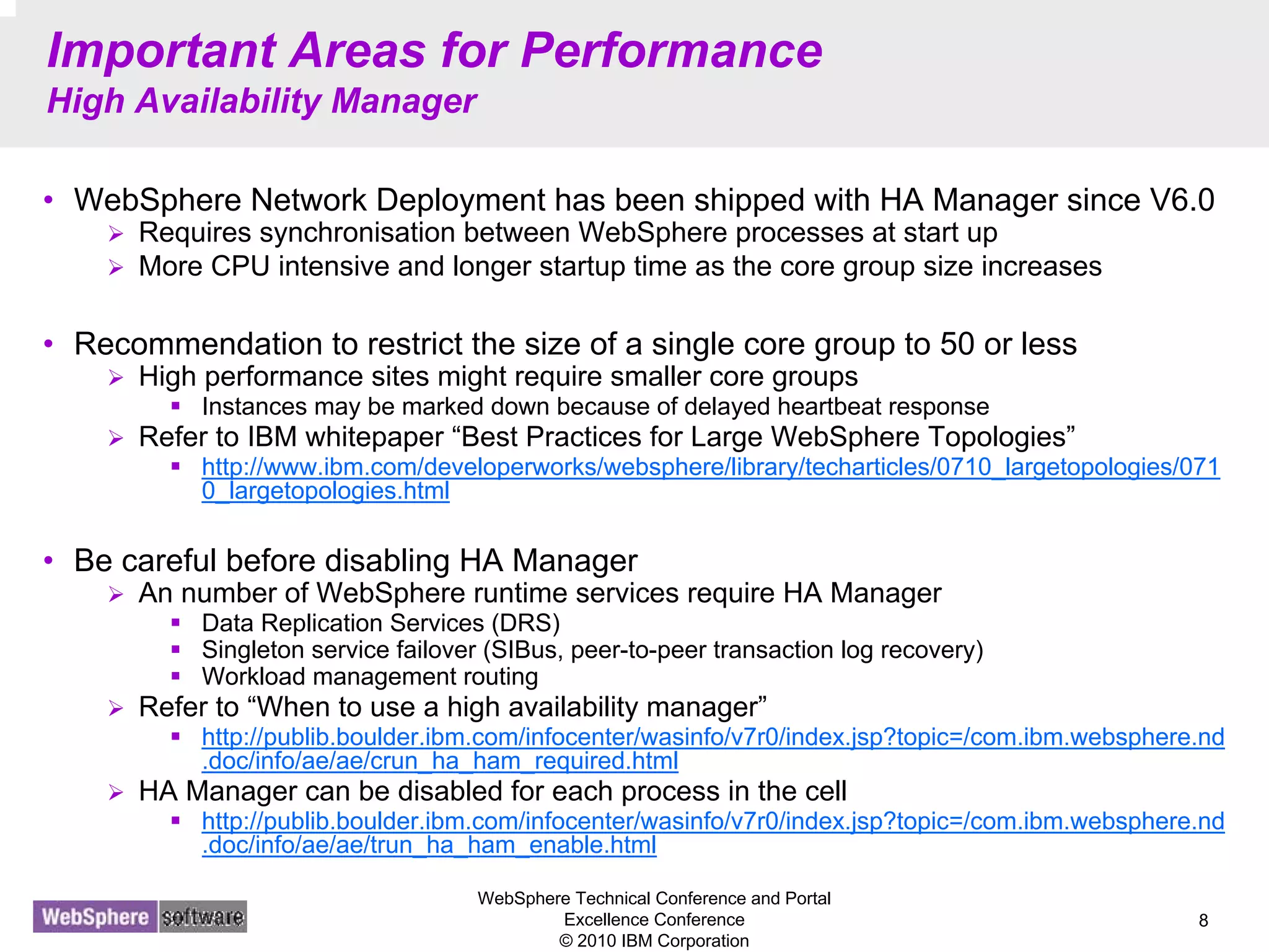
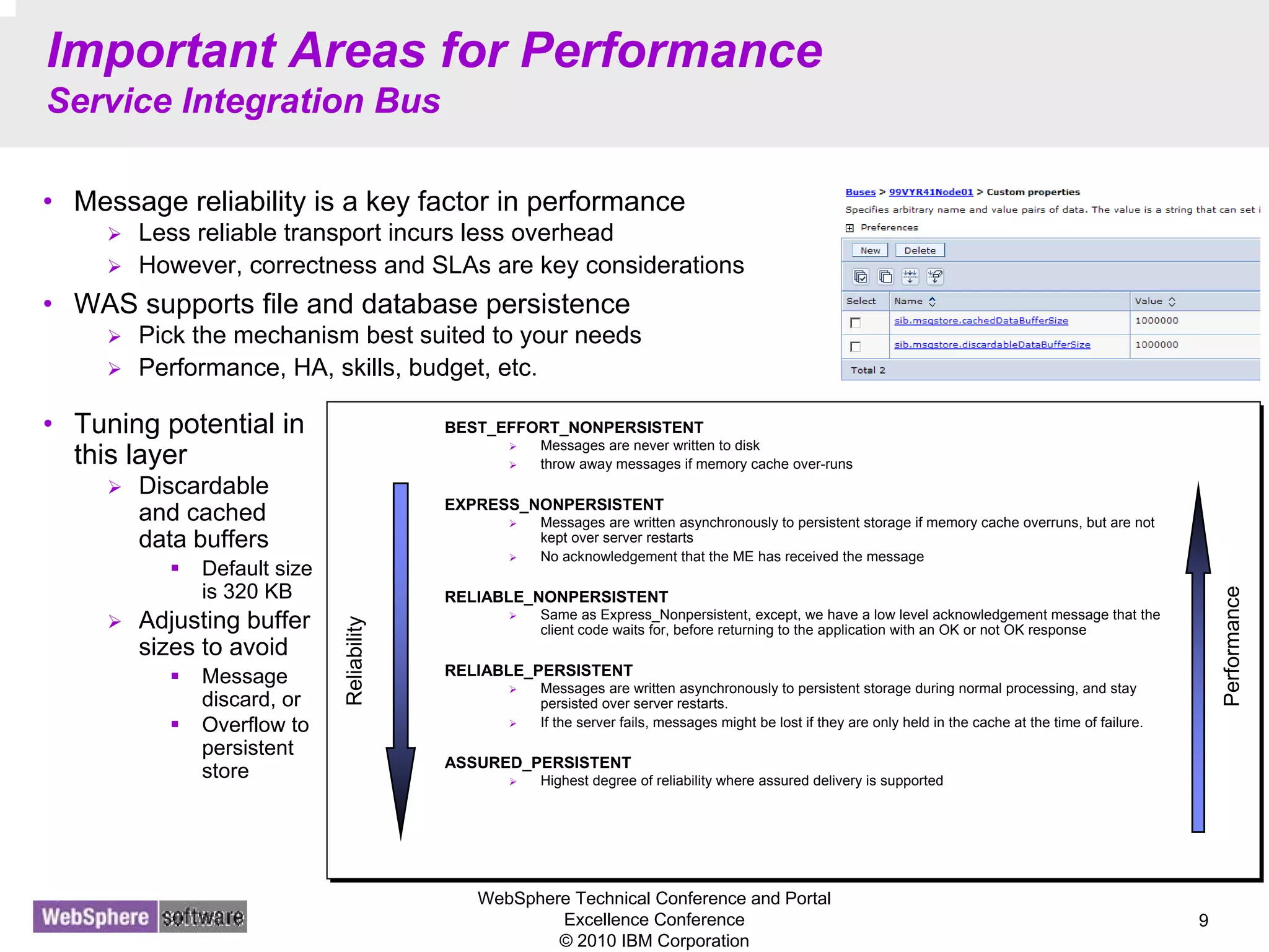
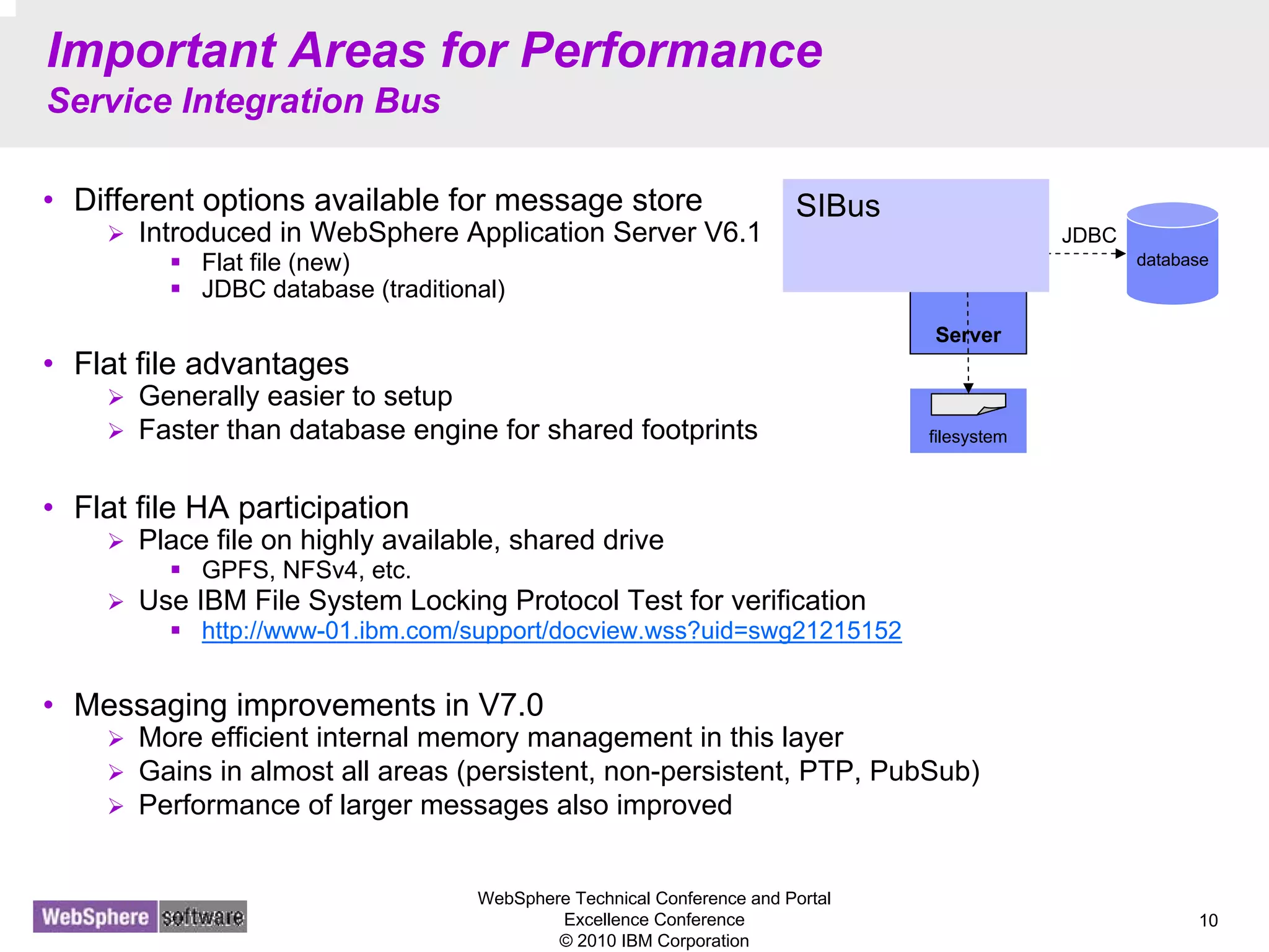
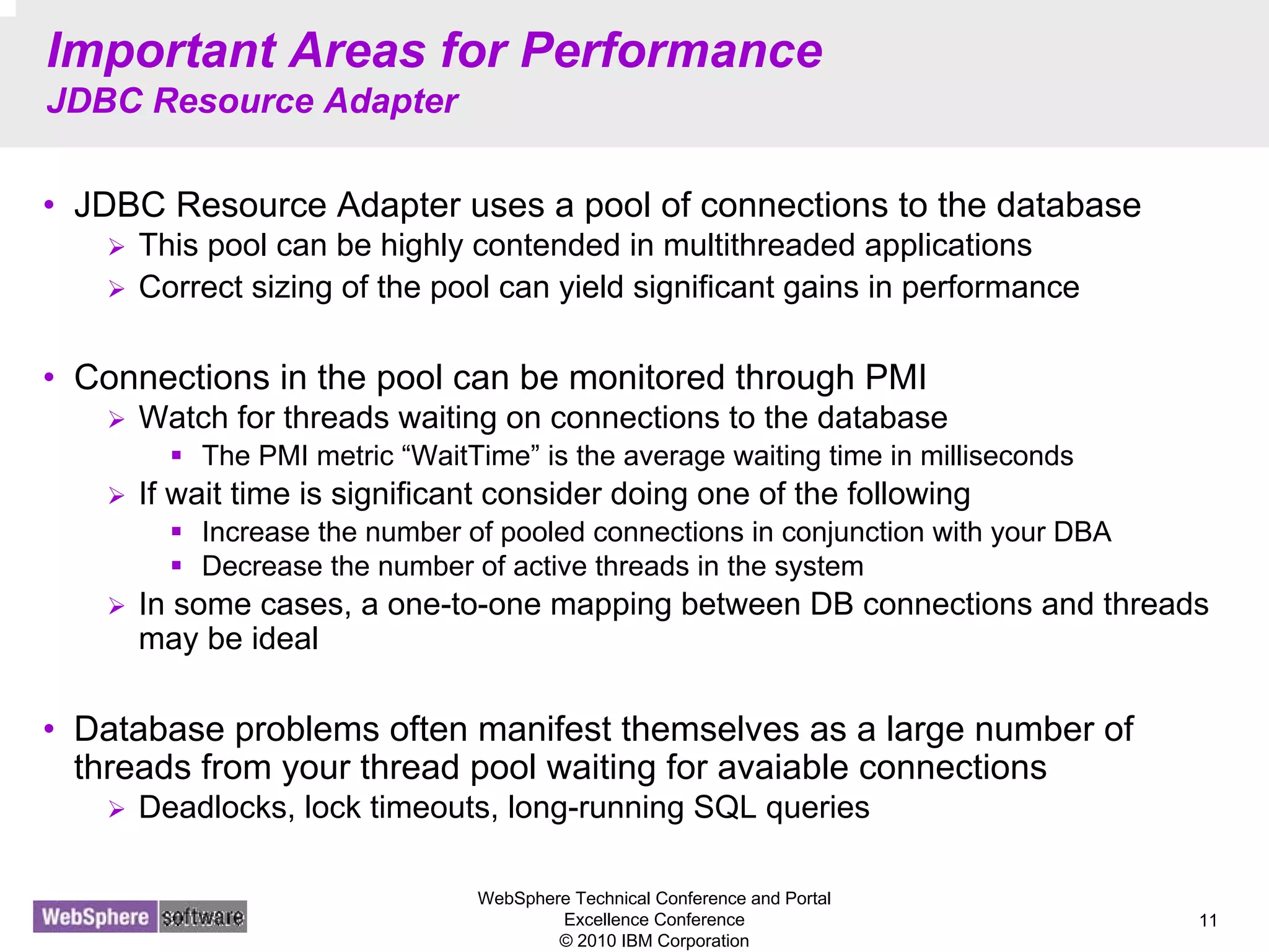
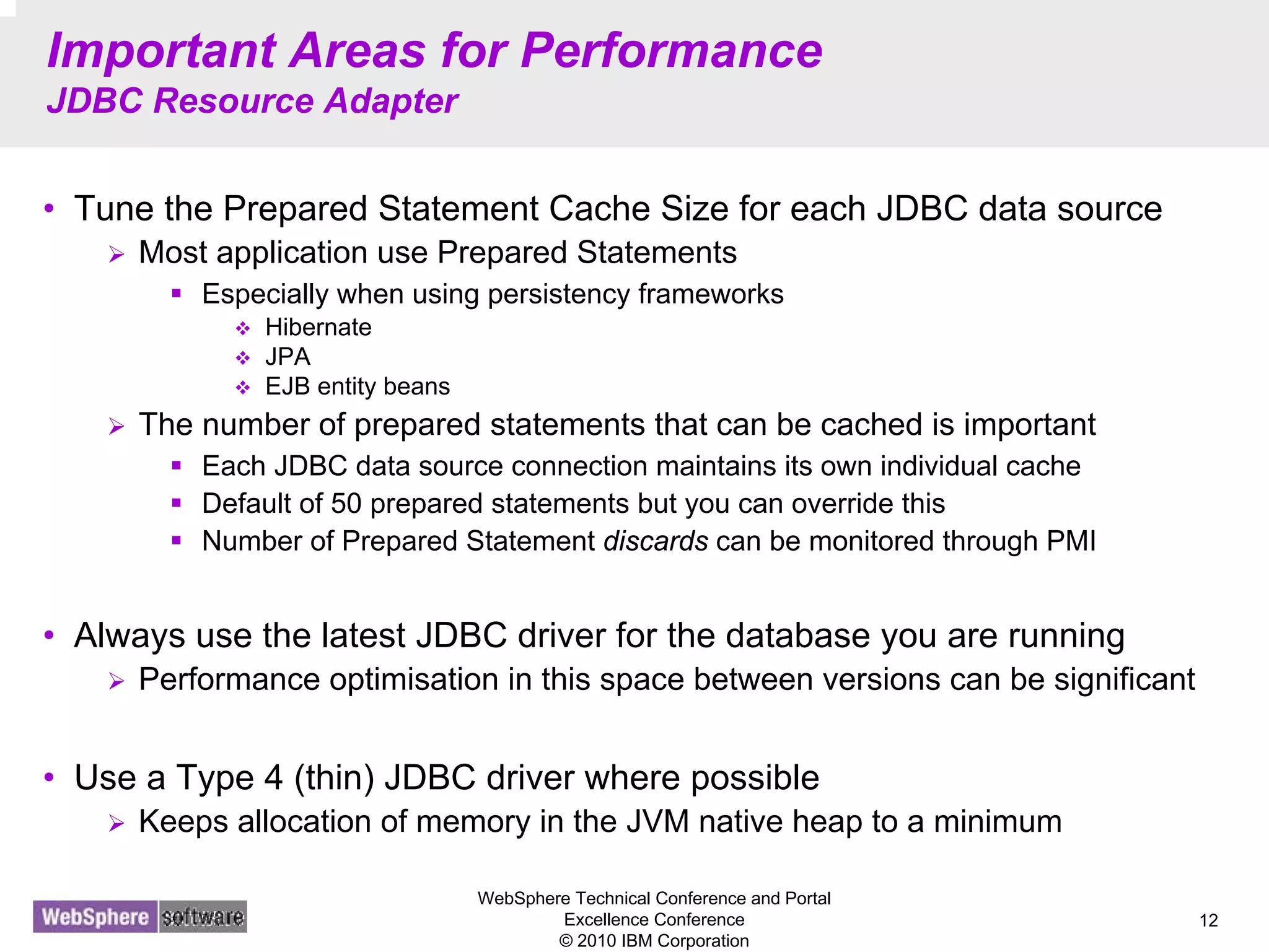
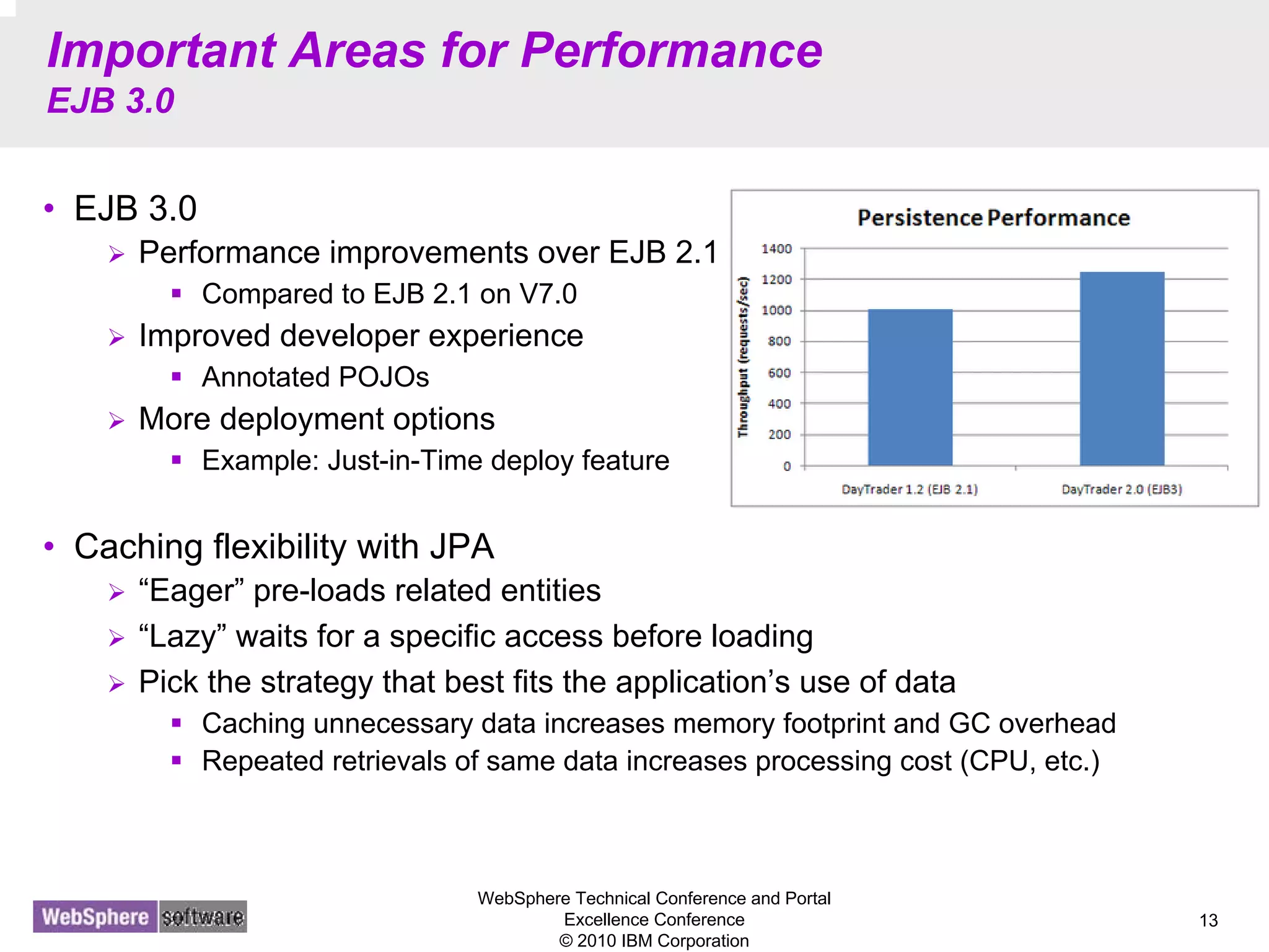
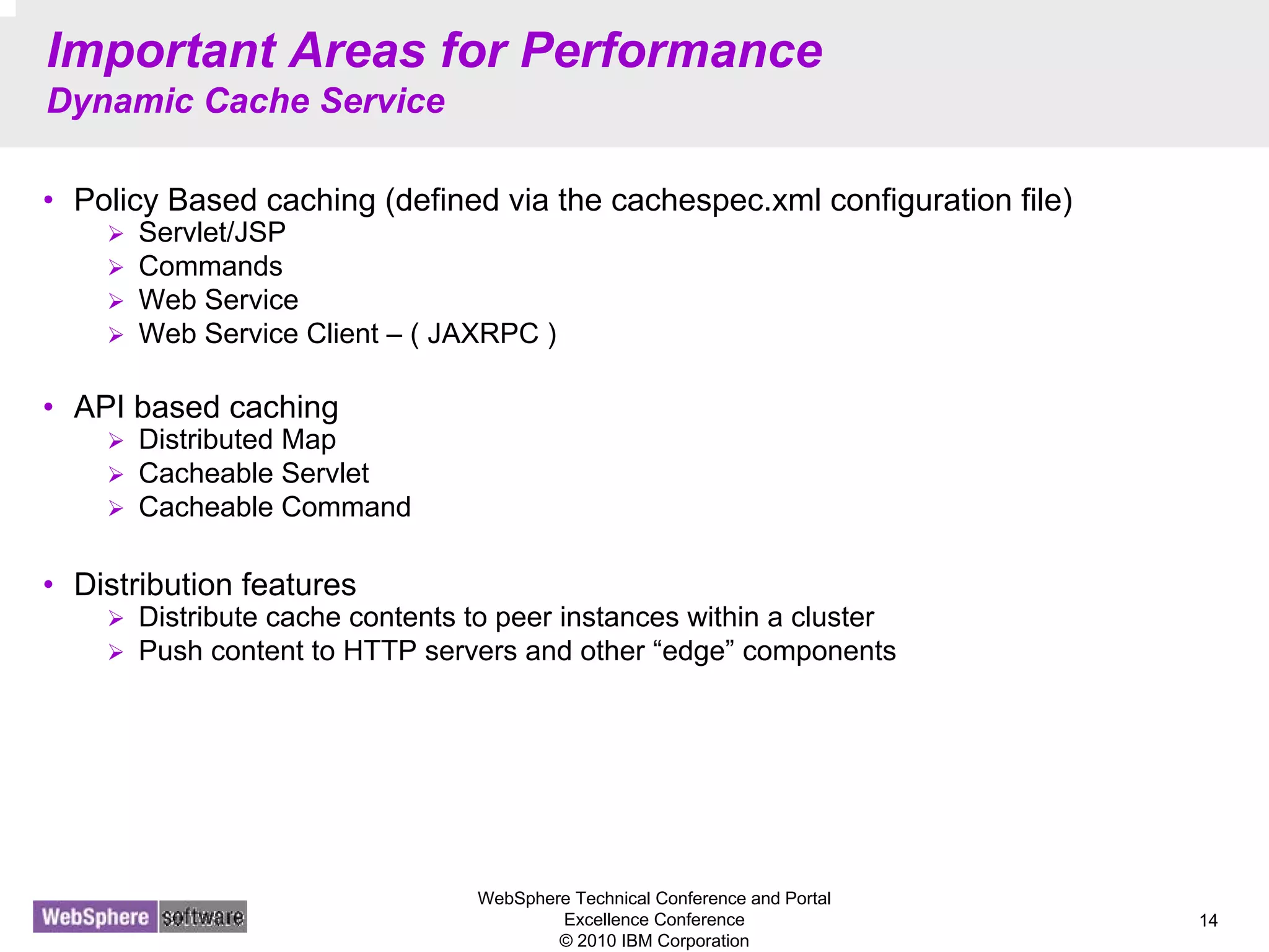
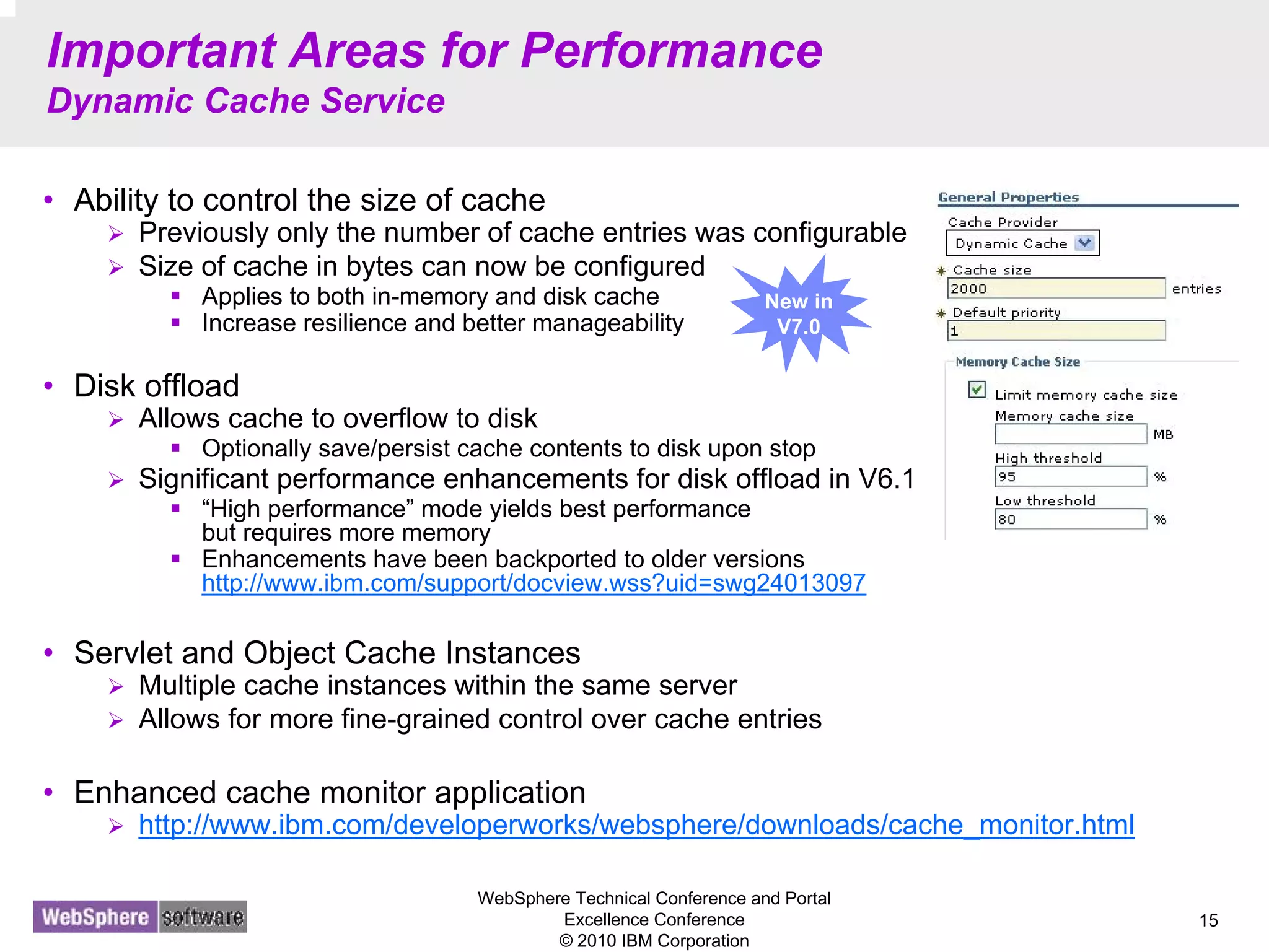
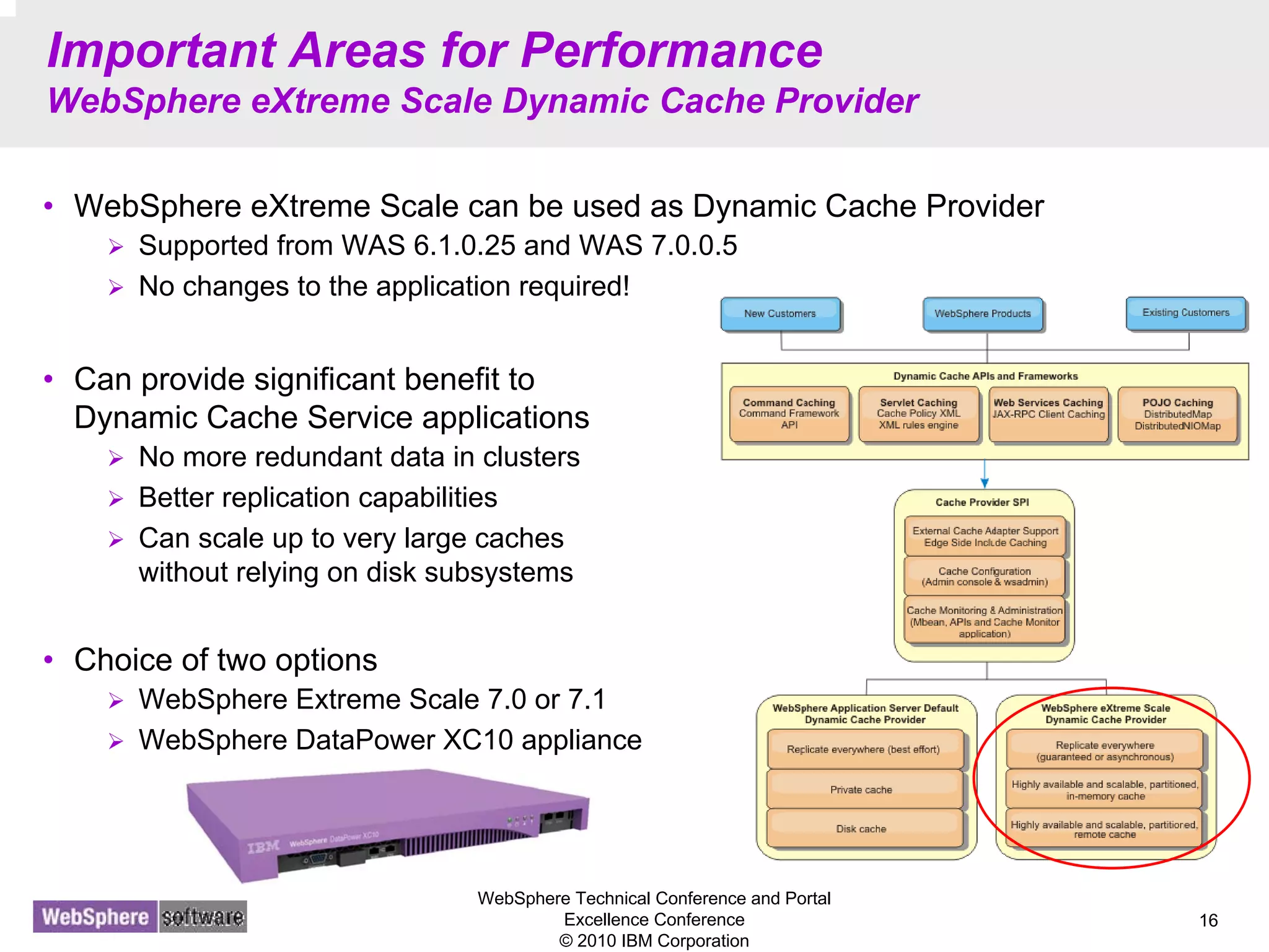
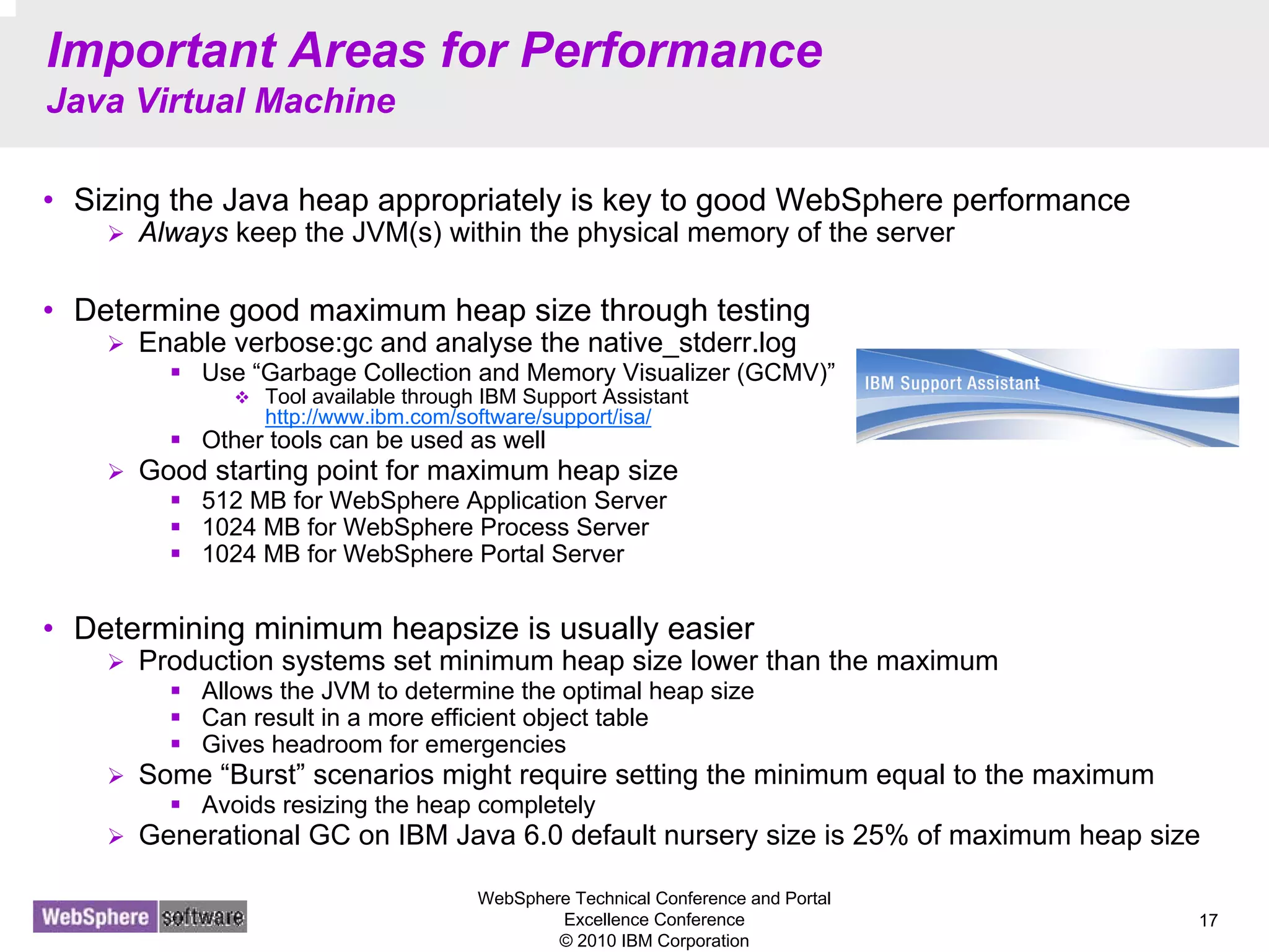
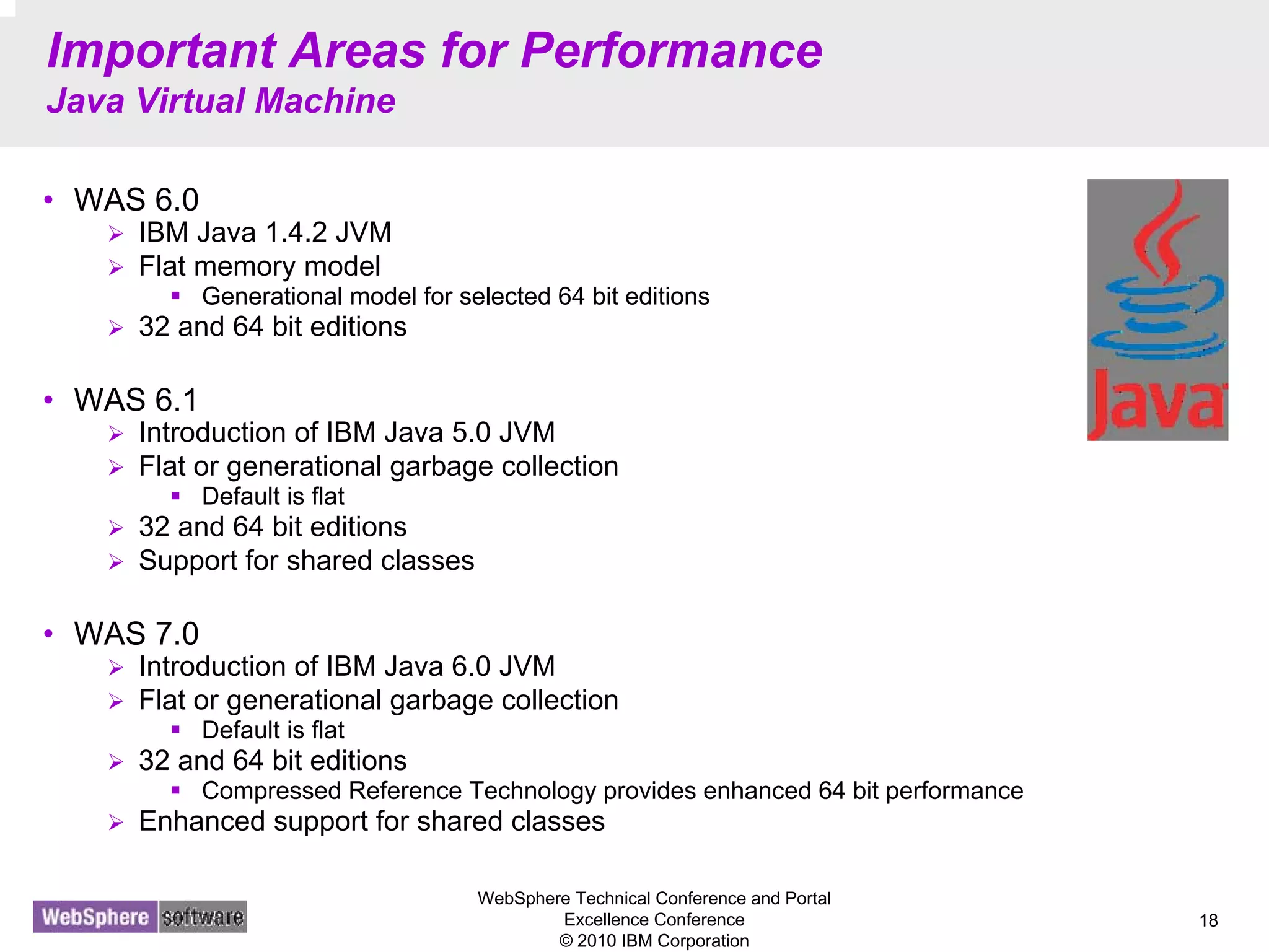
![WebSphere Technical Conference and Portal
Excellence Conference
© 2010 IBM Corporation
19
Important Areas for Performance
Java Virtual Machine – IBM Java 1.4.2 JVM
• Pinned and dosed objects are unmovable during compaction
Example: Native calls generate pinned objects
• Heap fragmentation could become an issue
Especially true with large objects
OutOfMemory occurs even if there appears to be sufficient free heap available
• kCluster is an area of storage for class blocks
Default size = 1280 (entries) x 256 (bytes)
Can be reset via JVM argument –Xk<size>
• pCluster is an area for pinned objects
16KB by default
Newly created pCluster are 2KB in size
Can be reset using but only on AIX when using the subpool GC policy
-Xp<iiii>[K][,<oooo>[K]]
iiii = initial pCluster size
oooo = size of subsequent overflow pClusters
AIX subpool
GC policy](https://image.slidesharecdn.com/w23-advancedperformancetacticsforwebsphereperformance-190729190055/75/W23-Advanced-Performance-Tactics-for-WebSphere-Performance-19-2048.jpg)
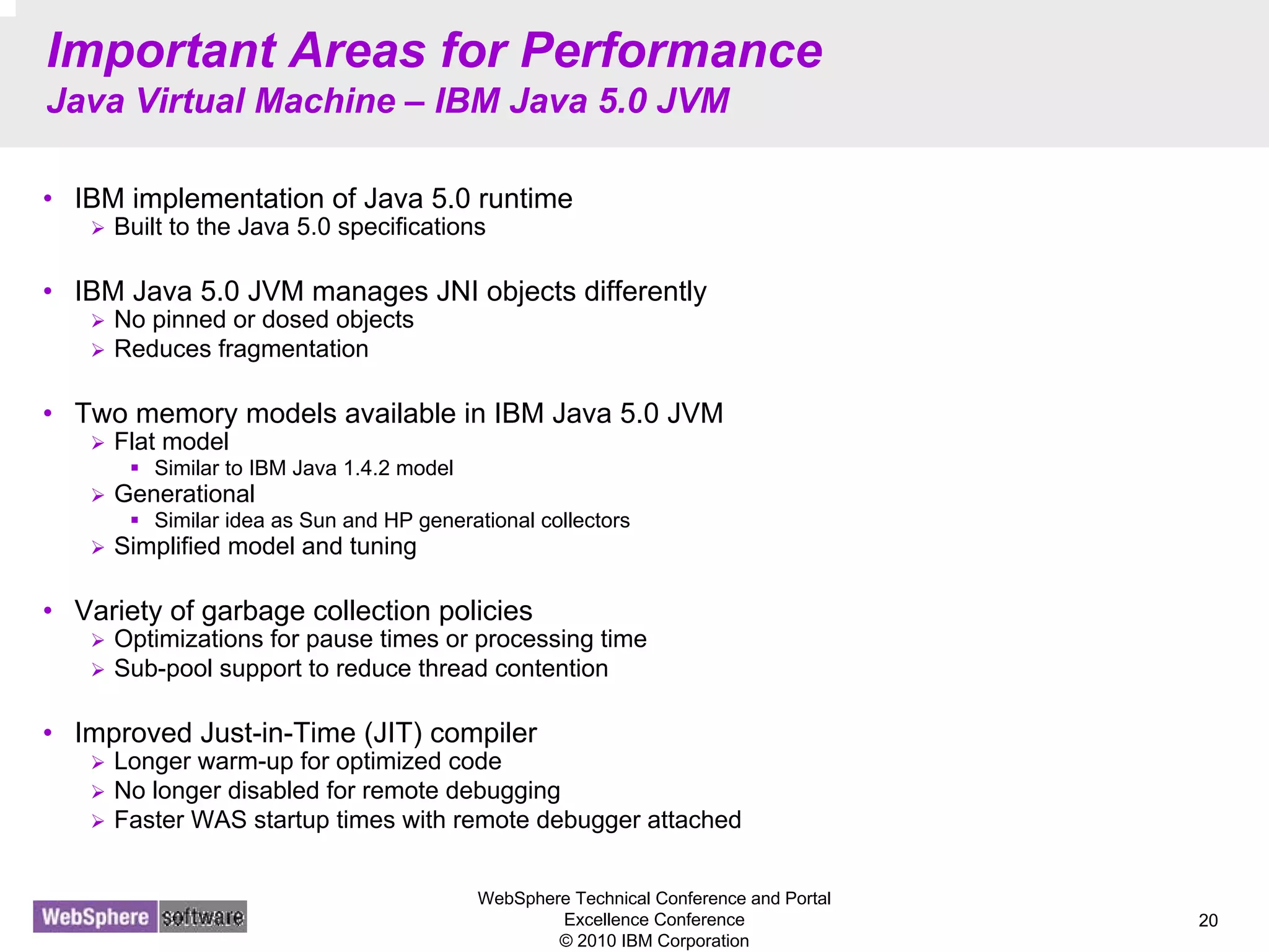
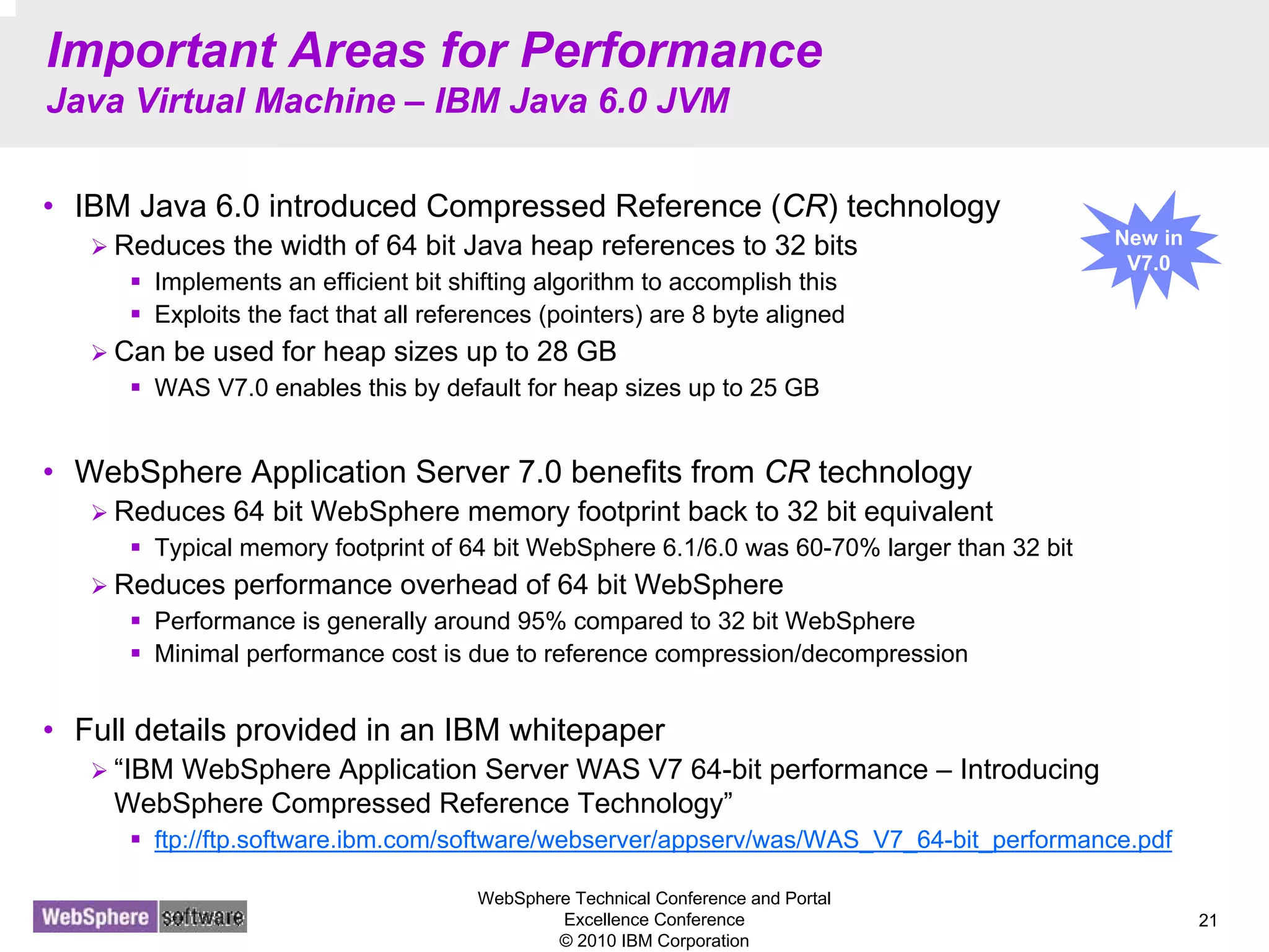

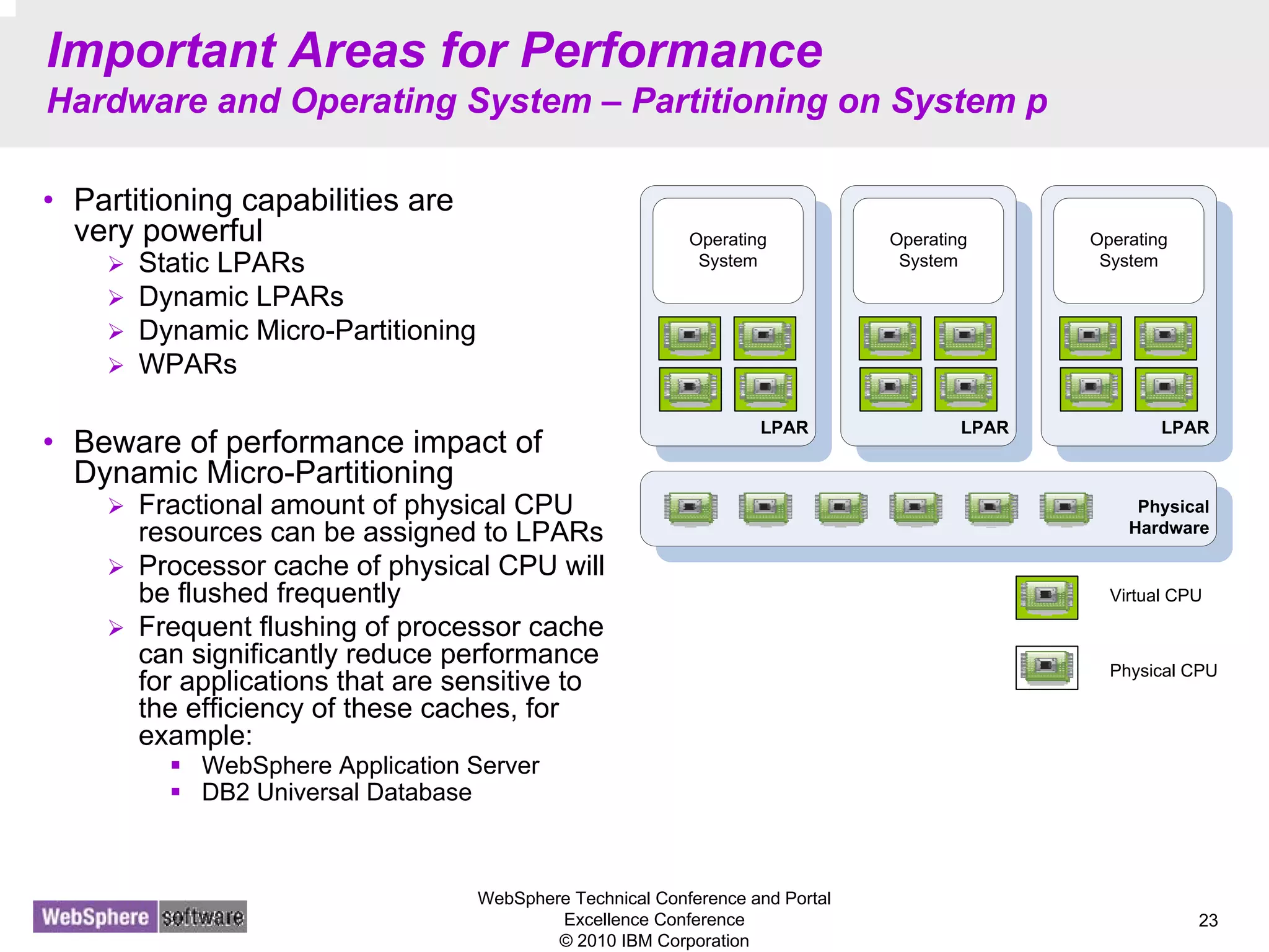
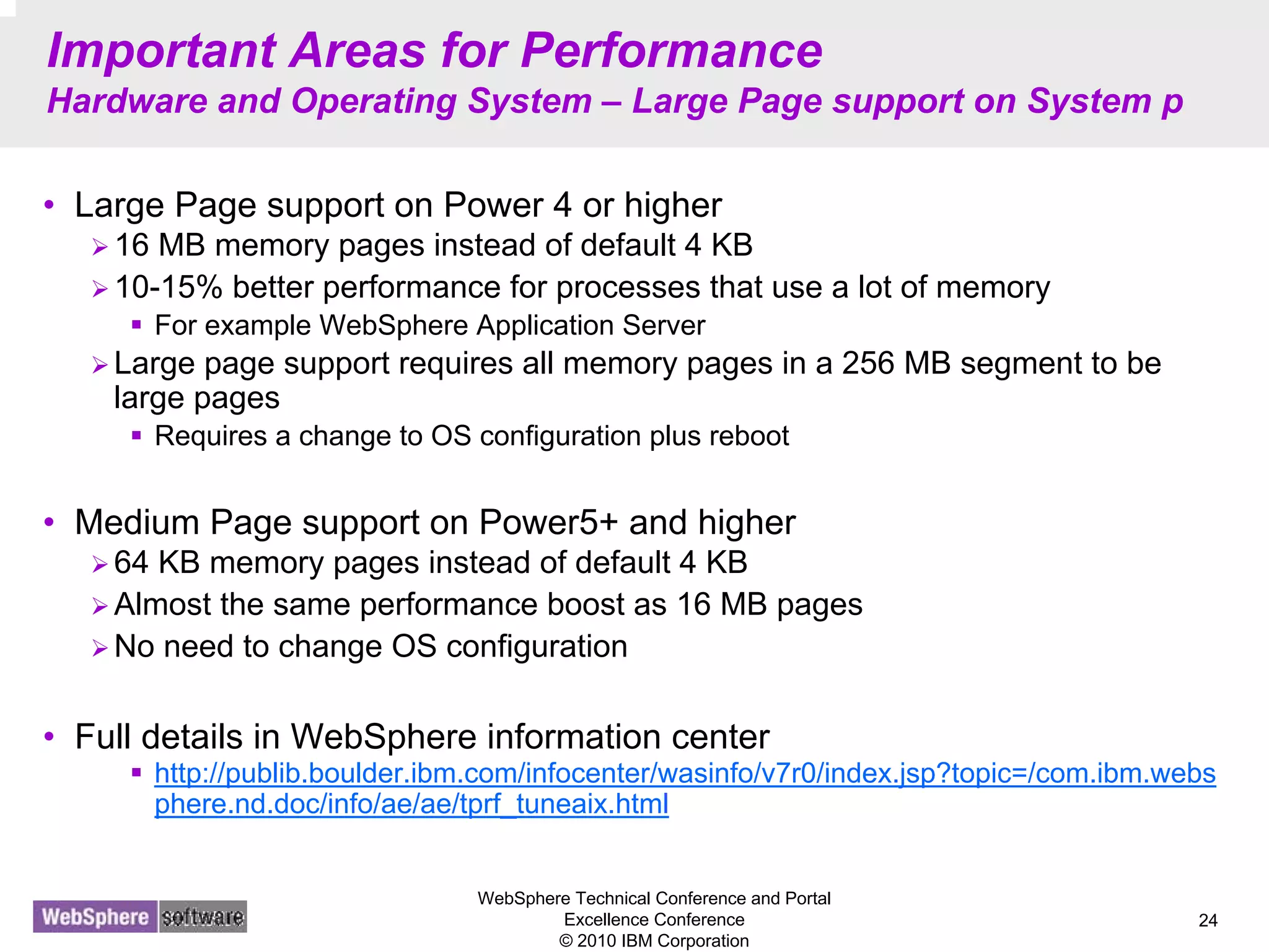
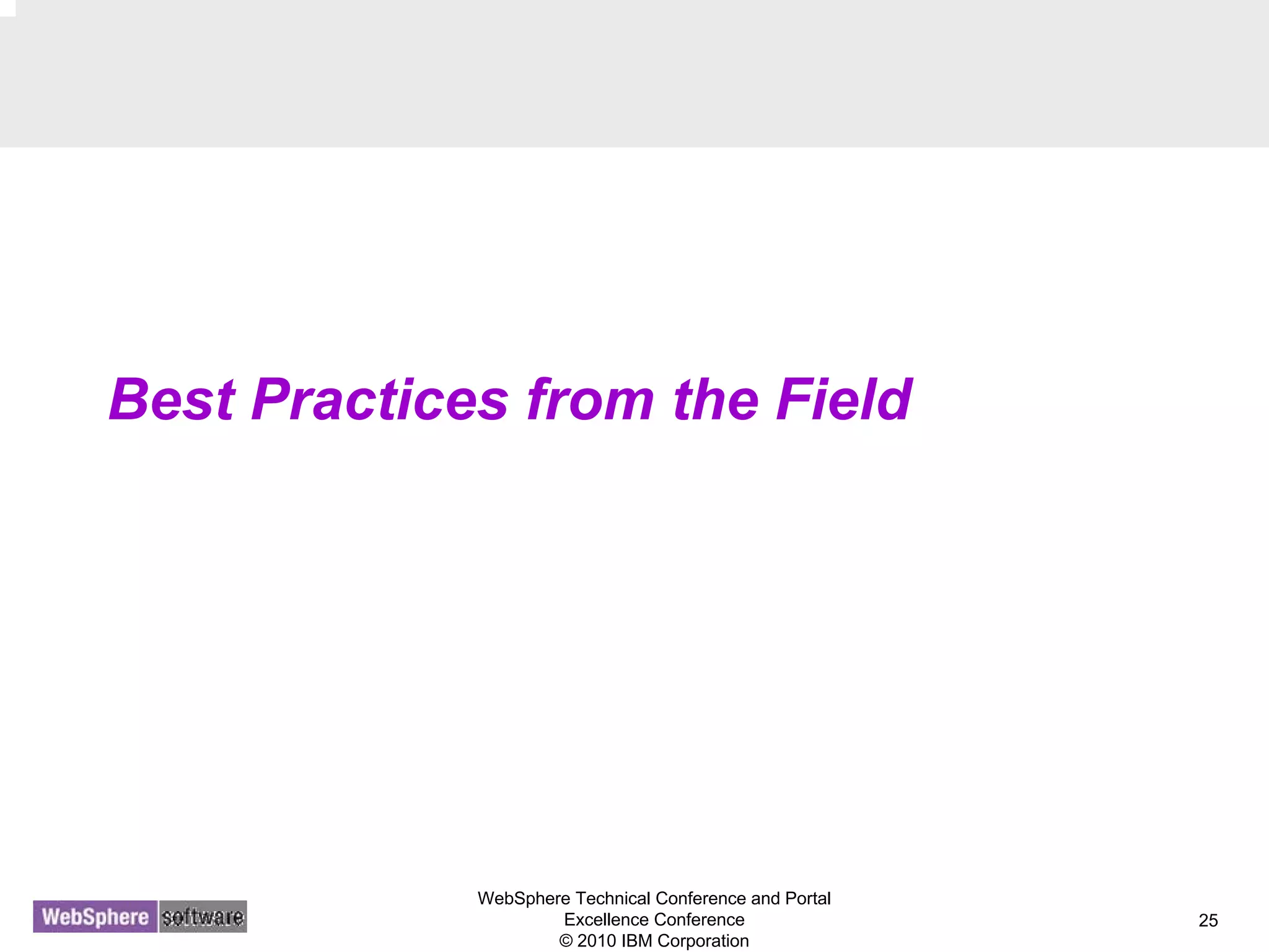
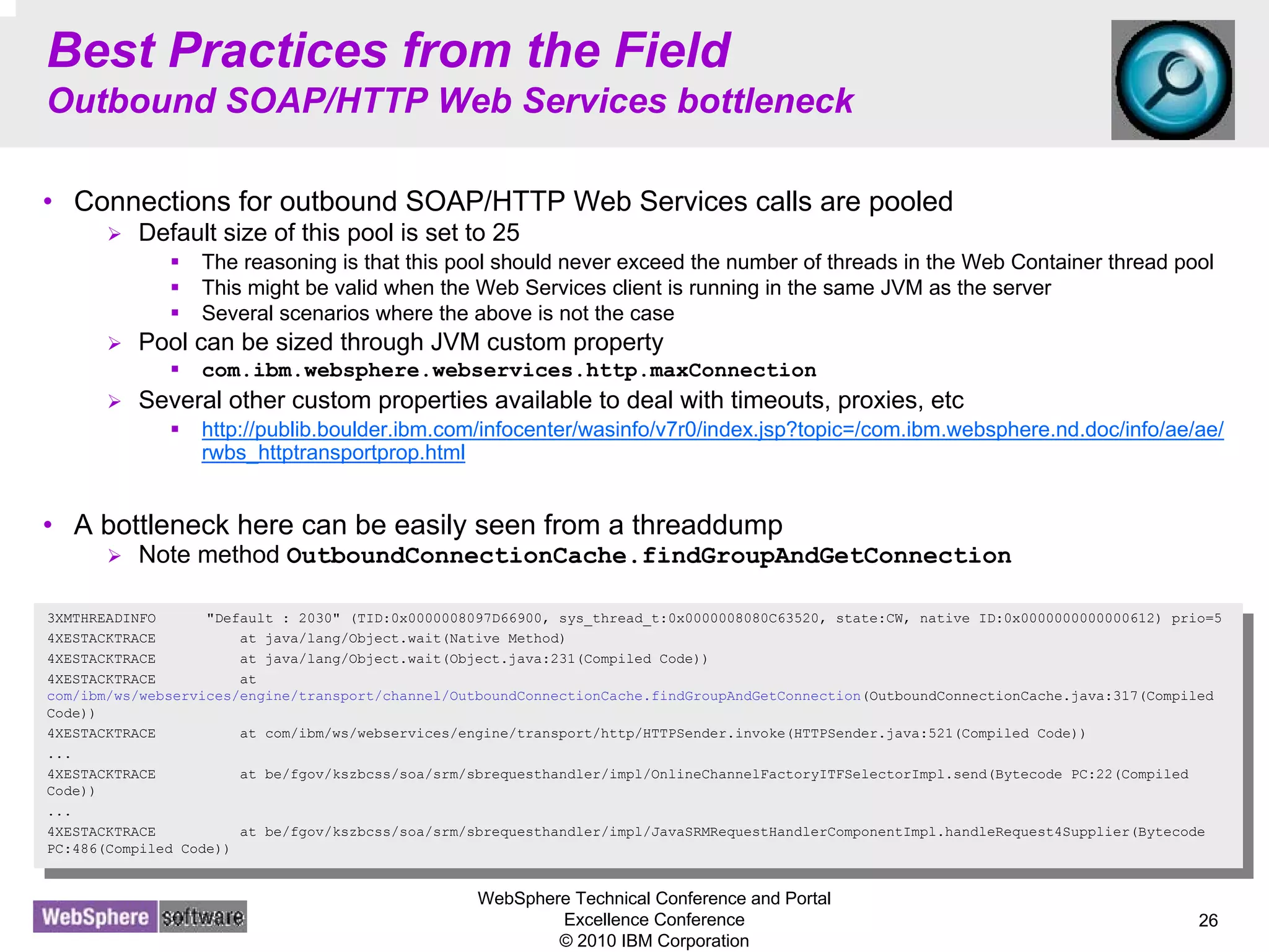
![WebSphere Technical Conference and Portal
Excellence Conference
© 2010 IBM Corporation
27
Best Practices from the Field
Configure Aggressive Hung Thread Detection Policy
• WebSphere has a built-in detection mechanism for long running threads
Logs a message to SystemOut.log if a thread has been active for over 600 seconds
Detection logic runs once every 180 seconds
• For OLPT workloads threads are not expected to run for more than a few seconds
Default threshold of 600 seconds is excessive
Long running threads keep hold of other resources so this condition should be avoided
Common misunderstanding that transaction timeouts would stop a running thread
Threshold can be overriden through a JVM custom property
com.ibm.websphere.threadmonitor.threshold
• WebSphere can also generate a threaddump when long running threads are detected
Can be very helpful for root-cause analysis especially in production environments
Can be enabled through a JVM custom property
com.ibm.websphere.threadmonitor.dump.java
• Full details available in the information center
http://publib.boulder.ibm.com/infocenter/wasinfo/v7r0/index.jsp?topic=/com.ibm.websphere.nd.doc/i
nfo/ae/ae/ttrb_confighangdet.html
[18/02/10 13:05:14:377 GMT] 00000014 ThreadMonitor W WSVR0605W: Thread "WebContainer : 52" (00000113) has
been active for 614687 milliseconds and may be hung. There is/are 1 thread(s) in total in the server that may
be hung.
[18/02/10 13:05:14:377 GMT] 00000014 ThreadMonitor W WSVR0605W: Thread "WebContainer : 52" (00000113) has
been active for 614687 milliseconds and may be hung. There is/are 1 thread(s) in total in the server that may
be hung.](https://image.slidesharecdn.com/w23-advancedperformancetacticsforwebsphereperformance-190729190055/75/W23-Advanced-Performance-Tactics-for-WebSphere-Performance-27-2048.jpg)
![WebSphere Technical Conference and Portal
Excellence Conference
© 2010 IBM Corporation
28
Best Practices from the Field
High CPU Utilisation with WebSphere V7.0 on AIX
• Customers observe high CPU utilisation when running WAS V7.0 on AIX
There is a known defect in IBM Java 6.0 SR6 and SR7 on AIX
The Java attach agent gets stuck in a loop trying to open a metaphore
http://www-01.ibm.com/support/docview.wss?uid=isg1IZ73533
• The above problem can be confirmed from a thread dump as shown below
• Problem has been resolved in IBM Java 6.0 SR8
Workaround is to disable the Java attach agent
Use JVM custom property com.ibm.tools.attach.enable=no
3XMTHREADINFO "Attach handler" J9VMThread:0x00000000300A4400, j9thread_t:0x0000000111DA5DC0,
java/lang/Thread:0x0000000040035980, state:CW, prio=6
3XMTHREADINFO1 (native thread ID:0x26600CD, native priority:0x6, native policy:UNKNOWN)
3XMTHREADINFO3 Java callstack:
4XESTACKTRACE at com/ibm/tools/attach/javaSE/IPC.openSemaphoreImpl(Native Method)
4XESTACKTRACE at com/ibm/tools/attach/javaSE/IPC.reopenSemaphore(IPC.java:182(Compiled Code))
4XESTACKTRACE at
com/ibm/tools/attach/javaSE/AttachHandler.waitForNotification(AttachHandler.java:181(Compiled Code))
4XESTACKTRACE at com/ibm/tools/attach/javaSE/AttachHandler.run(AttachHandler.java:163(Compiled
Code))
3XMTHREADINFO3 Native callstack:
4XENATIVESTACK _event_wait+0x2b8 (0x090000000070985C [libpthreads.a+0x1685c])
4XENATIVESTACK _cond_wait_local+0x4e4 (0x0900000000717568 [libpthreads.a+0x24568])
4XENATIVESTACK _cond_wait+0xbc (0x0900000000717B40 [libpthreads.a+0x24b40])
4XENATIVESTACK pthread_cond_wait+0x1a8 (0x09000000007187AC [libpthreads.a+0x257ac])
3XMTHREADINFO "Attach handler" J9VMThread:0x00000000300A4400, j9thread_t:0x0000000111DA5DC0,
java/lang/Thread:0x0000000040035980, state:CW, prio=6
3XMTHREADINFO1 (native thread ID:0x26600CD, native priority:0x6, native policy:UNKNOWN)
3XMTHREADINFO3 Java callstack:
4XESTACKTRACE at com/ibm/tools/attach/javaSE/IPC.openSemaphoreImpl(Native Method)
4XESTACKTRACE at com/ibm/tools/attach/javaSE/IPC.reopenSemaphore(IPC.java:182(Compiled Code))
4XESTACKTRACE at
com/ibm/tools/attach/javaSE/AttachHandler.waitForNotification(AttachHandler.java:181(Compiled Code))
4XESTACKTRACE at com/ibm/tools/attach/javaSE/AttachHandler.run(AttachHandler.java:163(Compiled
Code))
3XMTHREADINFO3 Native callstack:
4XENATIVESTACK _event_wait+0x2b8 (0x090000000070985C [libpthreads.a+0x1685c])
4XENATIVESTACK _cond_wait_local+0x4e4 (0x0900000000717568 [libpthreads.a+0x24568])
4XENATIVESTACK _cond_wait+0xbc (0x0900000000717B40 [libpthreads.a+0x24b40])
4XENATIVESTACK pthread_cond_wait+0x1a8 (0x09000000007187AC [libpthreads.a+0x257ac])](https://image.slidesharecdn.com/w23-advancedperformancetacticsforwebsphereperformance-190729190055/75/W23-Advanced-Performance-Tactics-for-WebSphere-Performance-28-2048.jpg)
![WebSphere Technical Conference and Portal
Excellence Conference
© 2010 IBM Corporation
29
Best Practices from the Field
Energy savings mode can limit performance
• Modern platforms such as Power7
provide several energy saving options
“Dynamic Power Saver” – reduces CPU
frequency depending on worload
“Static Power Saver” – reduces CPU
frequency permanently
• Make sure that “Static Power Saver” is
not enabled when performance is vital
Can be disabled through Hardware
Management Console (HMC)
Use “lparstat” to confirm this
http://www.ibm.com/developerworks/wikis/display/Wiki
Ptype/CPU+frequency+monitoring+using+lparstat
lp_newpap_904_st: /home/wasadmin>lparstat –E 2 2
System configuration: type=Shared mode=Uncapped smt=4 lcpu=16 mem=34816MB psize=12 ent=4.00
--------Actual-------- freq ------Normalised------
user sys wait idle --------- user sys wait idle
12.56 2.510 0.249 0.681 2.1GHz[ 70%] 8.792 1.757 0.174 5.277
12.13 2.602 0.237 1.031 2.1GHz[ 70%] 8.491 1.821 0.166 5.522
lp_newpap_904_st: /home/wasadmin>lparstat –E 2 2
System configuration: type=Shared mode=Uncapped smt=4 lcpu=16 mem=34816MB psize=12 ent=4.00
--------Actual-------- freq ------Normalised------
user sys wait idle --------- user sys wait idle
12.56 2.510 0.249 0.681 2.1GHz[ 70%] 8.792 1.757 0.174 5.277
12.13 2.602 0.237 1.031 2.1GHz[ 70%] 8.491 1.821 0.166 5.522
Physical CPU vs Entitlement - lp_newpap_904_st
0.0
0.5
1.0
1.5
2.0
2.5
3.0
3.5
4.0
4.5
PhysicalCPU entitled
70%](https://image.slidesharecdn.com/w23-advancedperformancetacticsforwebsphereperformance-190729190055/75/W23-Advanced-Performance-Tactics-for-WebSphere-Performance-29-2048.jpg)
